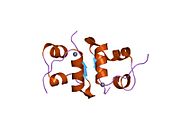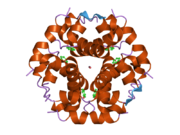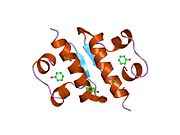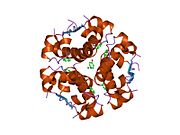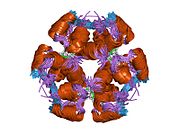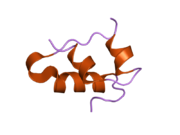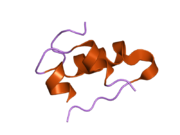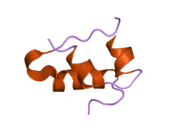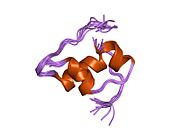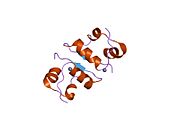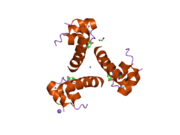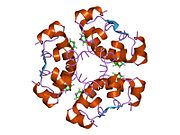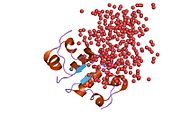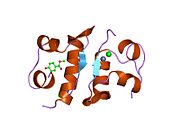Insulin: Difference between revisions
No edit summary |
No edit summary |
||
| (2 intermediate revisions by the same user not shown) | |||
| Line 1: | Line 1: | ||
<languages /> | |||
<translate> | |||
<!--T:1--> | |||
{{Short description|Peptide hormone}} | {{Short description|Peptide hormone}} | ||
{{About|the naturally occurring protein|uses of insulin in treating diabetes|Insulin (medication)}} | {{About|the naturally occurring protein|uses of insulin in treating diabetes|Insulin (medication)}} | ||
{{#invoke:Infobox_gene|getTemplateData|QID= | {{#invoke:Infobox_gene|getTemplateData|QID=Q21542}} | ||
<!--T:2--> | |||
[[File: Insulin chain A and B linked by disulfide bridges.gif|frame|right|Insulin is a peptide hormone containing two chains cross-linked by disulfide bridges.]] | [[File: Insulin chain A and B linked by disulfide bridges.gif|frame|right|Insulin is a peptide hormone containing two chains cross-linked by disulfide bridges.]] | ||
'''Insulin''' ({{IPAc-en|ˈ|ɪ|n|.|sj|ʊ|.|l|ɪ|n}}, from [[Latin]] ''insula'', 'island') is a [[peptide hormone]] produced by [[beta cell]]s of the [[pancreatic islets]] encoded in humans by the insulin (''INS)'' [[gene]]. It is considered to be the main [[Anabolism|anabolic]] [[hormone]] of the body. It regulates the [[metabolism]] of [[carbohydrate]]s, [[fat]]s and [[protein]] by promoting the absorption of [[glucose]] from the blood into [[liver]], [[fat cell|fat]] and [[skeletal muscle]] cells. In these tissues the absorbed glucose is converted into either [[glycogen]] via [[glycogenesis]] or [[Fatty acid metabolism#Glycolytic end products are used in the conversion of carbohydrates into fatty acids|fats]] ([[triglyceride]]s) via [[lipogenesis]], or, in the case of the liver, into both. [[Glucose]] production and [[secretion]] by the liver is strongly inhibited by high concentrations of insulin in the blood. Circulating insulin also affects the synthesis of proteins in a wide variety of tissues. It is therefore an anabolic hormone, promoting the conversion of small molecules in the blood into large molecules inside the cells. Low insulin levels in the blood have the opposite effect by promoting widespread [[catabolism]], especially of [[obesity|reserve body fat]]. | '''Insulin''' ({{IPAc-en|ˈ|ɪ|n|.|sj|ʊ|.|l|ɪ|n}}, from [[Latin]] ''insula'', 'island') is a [[peptide hormone]] produced by [[beta cell]]s of the [[pancreatic islets]] encoded in humans by the insulin (''INS)'' [[gene]]. It is considered to be the main [[Anabolism|anabolic]] [[hormone]] of the body. It regulates the [[metabolism]] of [[carbohydrate]]s, [[fat]]s and [[protein]] by promoting the absorption of [[glucose]] from the blood into [[liver]], [[fat cell|fat]] and [[skeletal muscle]] cells. In these tissues the absorbed glucose is converted into either [[glycogen]] via [[glycogenesis]] or [[Fatty acid metabolism#Glycolytic end products are used in the conversion of carbohydrates into fatty acids|fats]] ([[triglyceride]]s) via [[lipogenesis]], or, in the case of the liver, into both. [[Glucose]] production and [[secretion]] by the liver is strongly inhibited by high concentrations of insulin in the blood. Circulating insulin also affects the synthesis of proteins in a wide variety of tissues. It is therefore an anabolic hormone, promoting the conversion of small molecules in the blood into large molecules inside the cells. Low insulin levels in the blood have the opposite effect by promoting widespread [[catabolism]], especially of [[obesity|reserve body fat]]. | ||
<!--T:3--> | |||
<!-- Regulation --> | <!-- Regulation --> | ||
[[Beta cell]]s are sensitive to [[blood sugar level]]s so that they secrete insulin into the blood in response to high level of glucose, and inhibit secretion of insulin when glucose levels are low. Insulin production is also regulated by glucose: high glucose promotes insulin production while low glucose levels lead to lower production. Insulin enhances glucose uptake and metabolism in the cells, thereby reducing blood sugar level. Their neighboring [[alpha cell]]s, by taking their cues from the beta cells, secrete [[glucagon]] into the blood in the opposite manner: increased secretion when blood glucose is low, and decreased secretion when glucose concentrations are high. Glucagon increases blood glucose level by stimulating [[glycogenolysis]] and [[gluconeogenesis]] in the liver. The secretion of insulin and glucagon into the blood in response to the blood glucose concentration is the primary mechanism of [[Blood sugar regulation|glucose homeostasis]]. | [[Beta cell]]s are sensitive to [[blood sugar level]]s so that they secrete insulin into the blood in response to high level of glucose, and inhibit secretion of insulin when glucose levels are low. Insulin production is also regulated by glucose: high glucose promotes insulin production while low glucose levels lead to lower production. Insulin enhances glucose uptake and metabolism in the cells, thereby reducing blood sugar level. Their neighboring [[alpha cell]]s, by taking their cues from the beta cells, secrete [[glucagon]] into the blood in the opposite manner: increased secretion when blood glucose is low, and decreased secretion when glucose concentrations are high. Glucagon increases blood glucose level by stimulating [[glycogenolysis]] and [[gluconeogenesis]] in the liver. The secretion of insulin and glucagon into the blood in response to the blood glucose concentration is the primary mechanism of [[Blood sugar regulation|glucose homeostasis]]. | ||
<!--T:4--> | |||
<!-- Clinical significance --> | <!-- Clinical significance --> | ||
Decreased or absent insulin activity results in [[diabetes]], a condition of high blood sugar level ([[hyperglycaemia]]). There are two types of the disease. In [[type 1 diabetes]], the beta cells are destroyed by an [[autoimmunity|autoimmune reaction]] so that insulin can no longer be synthesized or be secreted into the blood. In [[type 2 diabetes]], the destruction of beta cells is less pronounced than in type 1, and is not due to an autoimmune process. Instead, there is an accumulation of [[amyloid]] in the pancreatic islets, which likely disrupts their anatomy and physiology. The [[pathogenesis]] of type 2 diabetes is not well understood but reduced population of islet beta-cells, reduced secretory function of islet beta-cells that survive, and peripheral tissue insulin resistance are known to be involved. Type 2 diabetes is characterized by increased glucagon secretion which is unaffected by, and unresponsive to the concentration of blood glucose. But insulin is still secreted into the blood in response to the blood glucose. As a result, glucose accumulates in the blood. | Decreased or absent insulin activity results in [[diabetes]], a condition of high blood sugar level ([[hyperglycaemia]]). There are two types of the disease. In [[type 1 diabetes]], the beta cells are destroyed by an [[autoimmunity|autoimmune reaction]] so that insulin can no longer be synthesized or be secreted into the blood. In [[type 2 diabetes]], the destruction of beta cells is less pronounced than in type 1, and is not due to an autoimmune process. Instead, there is an accumulation of [[amyloid]] in the pancreatic islets, which likely disrupts their anatomy and physiology. The [[pathogenesis]] of type 2 diabetes is not well understood but reduced population of islet beta-cells, reduced secretory function of islet beta-cells that survive, and peripheral tissue insulin resistance are known to be involved. Type 2 diabetes is characterized by increased glucagon secretion which is unaffected by, and unresponsive to the concentration of blood glucose. But insulin is still secreted into the blood in response to the blood glucose. As a result, glucose accumulates in the blood. | ||
<!--T:5--> | |||
<!-- Structure --> | <!-- Structure --> | ||
The human insulin protein is composed of 51 [[amino acid]]s, and has a [[molecular mass]] of 5808 [[Dalton (unit)|Da]]. It is a hetero[[protein dimer|dimer]] of an A-chain and a B-chain, which are linked together by [[disulfide bond]]s. Insulin's structure varies slightly between [[species]] of animals. Insulin from non-human animal sources differs somewhat in effectiveness (in [[carbohydrate metabolism]] effects) from human insulin because of these variations. [[Pig|Porcine]] insulin is especially close to the [[human]] version, and was widely used to treat type 1 diabetics before human insulin could be produced in large quantities by [[Recombinant DNA#Applications of recombinant DNA technology|recombinant DNA]] technologies. | The human insulin protein is composed of 51 [[amino acid]]s, and has a [[molecular mass]] of 5808 [[Dalton (unit)|Da]]. It is a hetero[[protein dimer|dimer]] of an A-chain and a B-chain, which are linked together by [[disulfide bond]]s. Insulin's structure varies slightly between [[species]] of animals. Insulin from non-human animal sources differs somewhat in effectiveness (in [[carbohydrate metabolism]] effects) from human insulin because of these variations. [[Pig|Porcine]] insulin is especially close to the [[human]] version, and was widely used to treat type 1 diabetics before human insulin could be produced in large quantities by [[Recombinant DNA#Applications of recombinant DNA technology|recombinant DNA]] technologies. | ||
<!--T:6--> | |||
<!-- History, society and culture --> | <!-- History, society and culture --> | ||
Insulin was the first peptide hormone discovered. [[Frederick Banting]] and [[Charles Best (medical scientist)|Charles Best]], working in the laboratory of [[John Macleod (physiologist)|John Macleod]] at the [[University of Toronto]], were the first to isolate insulin from dog pancreas in 1921. [[Frederick Sanger]] sequenced the amino acid structure in 1951, which made insulin the first protein to be fully sequenced. The [[crystal structure]] of insulin in the solid state was determined by [[Dorothy Hodgkin]] in 1969. Insulin is also the first protein to be chemically synthesised and produced by [[Recombinant DNA|DNA recombinant technology]]. It is on the [[WHO Model List of Essential Medicines]], the most important medications needed in a basic [[health system]]. | Insulin was the first peptide hormone discovered. [[Frederick Banting]] and [[Charles Best (medical scientist)|Charles Best]], working in the laboratory of [[John Macleod (physiologist)|John Macleod]] at the [[University of Toronto]], were the first to isolate insulin from dog pancreas in 1921. [[Frederick Sanger]] sequenced the amino acid structure in 1951, which made insulin the first protein to be fully sequenced. The [[crystal structure]] of insulin in the solid state was determined by [[Dorothy Hodgkin]] in 1969. Insulin is also the first protein to be chemically synthesised and produced by [[Recombinant DNA|DNA recombinant technology]]. It is on the [[WHO Model List of Essential Medicines]], the most important medications needed in a basic [[health system]]. | ||
== Evolution and species distribution == | == Evolution and species distribution == <!--T:7--> | ||
<!--T:8--> | |||
Insulin may have originated more than a billion years ago. The molecular origins of insulin go at least as far back as the simplest unicellular [[eukaryotes]].Apart from animals, insulin-like proteins are also known to exist in [[fungi]] and [[protists]]. | Insulin may have originated more than a billion years ago. The molecular origins of insulin go at least as far back as the simplest unicellular [[eukaryotes]].Apart from animals, insulin-like proteins are also known to exist in [[fungi]] and [[protists]]. | ||
<!--T:9--> | |||
Insulin is produced by [[beta cells]] of the [[pancreatic islets]] in most vertebrates and by the [[Brockmann body]] in some [[teleost fish]]. [[Cone snail]]s: ''[[Conus geographus]]'' and ''[[Conus tulipa]]'', venomous sea snails that hunt small fish, use modified forms of insulin in their venom cocktails. The insulin toxin, closer in structure to fishes' than to snails' native insulin, slows down the prey fishes by lowering their blood glucose levels. | Insulin is produced by [[beta cells]] of the [[pancreatic islets]] in most vertebrates and by the [[Brockmann body]] in some [[teleost fish]]. [[Cone snail]]s: ''[[Conus geographus]]'' and ''[[Conus tulipa]]'', venomous sea snails that hunt small fish, use modified forms of insulin in their venom cocktails. The insulin toxin, closer in structure to fishes' than to snails' native insulin, slows down the prey fishes by lowering their blood glucose levels. | ||
== Production == | == Production == <!--T:10--> | ||
[[File:Insulin gene activation.png|thumb|upright=1.8|Diagram of insulin regulation upon high blood glucose]] | [[File:Insulin gene activation.png|thumb|upright=1.8|Diagram of insulin regulation upon high blood glucose]] | ||
Insulin is produced exclusively in the beta cells of the [[pancreatic islet]]s in mammals, and the Brockmann body in some fish. Human insulin is produced from the ''INS'' [[gene]], located on chromosome 11. Rodents have two functional insulin genes; one is the homolog of most mammalian genes (''Ins2''), and the other is a retroposed copy that includes promoter sequence but that is missing an intron (''Ins1''). [[Transcription (biology)|Transcription]] of the insulin gene increases in response to elevated blood glucose. This is primarily controlled by [[transcription factor]]s that bind [[Enhancer (genetics)|enhancer sequences]] in the ~400 [[base pair]]s before the gene's transcription start site. | Insulin is produced exclusively in the beta cells of the [[pancreatic islet]]s in mammals, and the Brockmann body in some fish. Human insulin is produced from the ''INS'' [[gene]], located on chromosome 11. Rodents have two functional insulin genes; one is the homolog of most mammalian genes (''Ins2''), and the other is a retroposed copy that includes promoter sequence but that is missing an intron (''Ins1''). [[Transcription (biology)|Transcription]] of the insulin gene increases in response to elevated blood glucose. This is primarily controlled by [[transcription factor]]s that bind [[Enhancer (genetics)|enhancer sequences]] in the ~400 [[base pair]]s before the gene's transcription start site. | ||
<!--T:11--> | |||
The major transcription factors influencing insulin secretion are [[PDX1]], [[NeuroD1]], and [[MafA]]. | The major transcription factors influencing insulin secretion are [[PDX1]], [[NeuroD1]], and [[MafA]]. | ||
<!--T:12--> | |||
During a low-glucose state, [[PDX1]] (pancreatic and duodenal homeobox protein 1) is located in the nuclear periphery as a result of interaction with [[HDAC1]] and [[HDAC2|2]], which results in downregulation of insulin secretion. An increase in blood [[glucose]] levels causes [[phosphorylation]] of [[PDX1]], which leads it to undergo nuclear translocation and bind the A3 element within the insulin promoter. Upon translocation it interacts with coactivators [[EP300|HAT p300]] and [[SETD7]]. [[PDX1]] affects the [[histone]] modifications through [[acetylation]] and deacetylation as well as [[methylation]]. It is also said to suppress [[glucagon]]. | During a low-glucose state, [[PDX1]] (pancreatic and duodenal homeobox protein 1) is located in the nuclear periphery as a result of interaction with [[HDAC1]] and [[HDAC2|2]], which results in downregulation of insulin secretion. An increase in blood [[glucose]] levels causes [[phosphorylation]] of [[PDX1]], which leads it to undergo nuclear translocation and bind the A3 element within the insulin promoter. Upon translocation it interacts with coactivators [[EP300|HAT p300]] and [[SETD7]]. [[PDX1]] affects the [[histone]] modifications through [[acetylation]] and deacetylation as well as [[methylation]]. It is also said to suppress [[glucagon]]. | ||
<!--T:13--> | |||
[[NeuroD1]], also known as β2, regulates insulin exocytosis in pancreatic [[β cells]] by directly inducing the expression of [[genes]] involved in exocytosis. It is localized in the [[cytosol]], but in response to high [[glucose]] it becomes [[glycosylated]] by [[OGT (gene)|OGT]] and/or [[phosphorylated]] by [[Extracellular signal-regulated kinases|ERK]], which causes translocation to the nucleus. In the nucleus β2 heterodimerizes with [[TCF3|E47]], binds to the E1 element of the insulin promoter and recruits co-activator [[EP300|p300]] which acetylates β2. It is able to interact with other transcription factors as well in activation of the insulin gene. | [[NeuroD1]], also known as β2, regulates insulin exocytosis in pancreatic [[β cells]] by directly inducing the expression of [[genes]] involved in exocytosis. It is localized in the [[cytosol]], but in response to high [[glucose]] it becomes [[glycosylated]] by [[OGT (gene)|OGT]] and/or [[phosphorylated]] by [[Extracellular signal-regulated kinases|ERK]], which causes translocation to the nucleus. In the nucleus β2 heterodimerizes with [[TCF3|E47]], binds to the E1 element of the insulin promoter and recruits co-activator [[EP300|p300]] which acetylates β2. It is able to interact with other transcription factors as well in activation of the insulin gene. | ||
<!--T:14--> | |||
[[MafA]] is degraded by [[proteasomes]] upon low blood [[glucose]] levels. Increased levels of [[glucose]] make an unknown protein [[glycosylated]]. This protein works as a transcription factor for [[MafA]] in an unknown manner and [[MafA]] is transported out of the cell. [[MafA]] is then translocated back into the nucleus where it binds the C1 element of the insulin promoter. | [[MafA]] is degraded by [[proteasomes]] upon low blood [[glucose]] levels. Increased levels of [[glucose]] make an unknown protein [[glycosylated]]. This protein works as a transcription factor for [[MafA]] in an unknown manner and [[MafA]] is transported out of the cell. [[MafA]] is then translocated back into the nucleus where it binds the C1 element of the insulin promoter. | ||
<!--T:15--> | |||
These transcription factors work synergistically and in a complex arrangement. Increased blood [[glucose]] can after a while destroy the binding capacities of these proteins, and therefore reduce the amount of insulin secreted, causing [[diabetes]]. The decreased binding activities can be mediated by [[glucose]] induced [[oxidative stress]] and [[antioxidants]] are said to prevent the decreased insulin secretion in glucotoxic pancreatic [[β cells]]. Stress signalling molecules and [[reactive oxygen species]] inhibits the insulin gene by interfering with the cofactors binding the transcription factors and the transcription factors itself. | These transcription factors work synergistically and in a complex arrangement. Increased blood [[glucose]] can after a while destroy the binding capacities of these proteins, and therefore reduce the amount of insulin secreted, causing [[diabetes]]. The decreased binding activities can be mediated by [[glucose]] induced [[oxidative stress]] and [[antioxidants]] are said to prevent the decreased insulin secretion in glucotoxic pancreatic [[β cells]]. Stress signalling molecules and [[reactive oxygen species]] inhibits the insulin gene by interfering with the cofactors binding the transcription factors and the transcription factors itself. | ||
<!--T:16--> | |||
Several [[regulatory sequence]]s in the [[Promoter (biology)|promoter]] region of the human insulin gene bind to [[transcription factor]]s. In general, the [[A-box]]es bind to [[Pdx1]] factors, [[E-box]]es bind to [[NeuroD]], C-boxes bind to [[MafA]], and [[cAMP response element]]s to [[CREB]]. There are also [[silencer (genetics)|silencers]] that inhibit transcription. | Several [[regulatory sequence]]s in the [[Promoter (biology)|promoter]] region of the human insulin gene bind to [[transcription factor]]s. In general, the [[A-box]]es bind to [[Pdx1]] factors, [[E-box]]es bind to [[NeuroD]], C-boxes bind to [[MafA]], and [[cAMP response element]]s to [[CREB]]. There are also [[silencer (genetics)|silencers]] that inhibit transcription. | ||
=== Synthesis === | === Synthesis === <!--T:17--> | ||
[[File:Insulin path.svg|thumb|upright=1.8|Insulin undergoes extensive posttranslational modification along the production pathway. Production and secretion are largely independent; prepared insulin is stored awaiting secretion. Both C-peptide and mature insulin are biologically active. Cell components and proteins in this image are not to scale.]] | [[File:Insulin path.svg|thumb|upright=1.8|Insulin undergoes extensive posttranslational modification along the production pathway. Production and secretion are largely independent; prepared insulin is stored awaiting secretion. Both C-peptide and mature insulin are biologically active. Cell components and proteins in this image are not to scale.]] | ||
<!--T:18--> | |||
Insulin is synthesized as an inactive precursor molecule, a 110 amino acid-long protein called "preproinsulin".<!-- Cite. Merged AA length from [[Preproinsulin]] --> Preproinsulin is [[translation (biology)|translated]] directly into the rough [[endoplasmic reticulum]] (RER), where its [[signal peptide]] is removed by [[signal peptidase]] to form "proinsulin". As the proinsulin [[protein folding|folds]], opposite ends of the protein, called the "A-chain" and the "B-chain", are fused together with three [[disulfide bond]]s. Folded proinsulin then transits through the [[Golgi apparatus]] and is packaged into specialized [[Vesicle (biology and chemistry)#Secretory vesicles|secretory vesicle]]s. In the granule, proinsulin is cleaved by [[Proprotein convertase 1|proprotein convertase 1/3]] and [[proprotein convertase 2]], removing the middle part of the protein, called the "[[C-peptide]]". Finally, [[carboxypeptidase E]] removes two pairs of amino acids from the protein's ends, resulting in active insulin – the insulin A- and B- chains, now connected with two disulfide bonds. | Insulin is synthesized as an inactive precursor molecule, a 110 amino acid-long protein called "preproinsulin".<!-- Cite. Merged AA length from [[Preproinsulin]] --> Preproinsulin is [[translation (biology)|translated]] directly into the rough [[endoplasmic reticulum]] (RER), where its [[signal peptide]] is removed by [[signal peptidase]] to form "proinsulin". As the proinsulin [[protein folding|folds]], opposite ends of the protein, called the "A-chain" and the "B-chain", are fused together with three [[disulfide bond]]s. Folded proinsulin then transits through the [[Golgi apparatus]] and is packaged into specialized [[Vesicle (biology and chemistry)#Secretory vesicles|secretory vesicle]]s. In the granule, proinsulin is cleaved by [[Proprotein convertase 1|proprotein convertase 1/3]] and [[proprotein convertase 2]], removing the middle part of the protein, called the "[[C-peptide]]". Finally, [[carboxypeptidase E]] removes two pairs of amino acids from the protein's ends, resulting in active insulin – the insulin A- and B- chains, now connected with two disulfide bonds. | ||
<!--T:19--> | |||
The resulting mature insulin is packaged inside mature granules waiting for metabolic signals (such as leucine, arginine, glucose and mannose) and [[Vagus nerve stimulation|vagal nerve stimulation]] to be exocytosed from the cell into the circulation. | The resulting mature insulin is packaged inside mature granules waiting for metabolic signals (such as leucine, arginine, glucose and mannose) and [[Vagus nerve stimulation|vagal nerve stimulation]] to be exocytosed from the cell into the circulation. | ||
<!--T:20--> | |||
Insulin and its related proteins have been shown to be produced inside the brain, and reduced levels of these proteins are linked to Alzheimer's disease. | Insulin and its related proteins have been shown to be produced inside the brain, and reduced levels of these proteins are linked to Alzheimer's disease. | ||
<!--T:21--> | |||
Insulin release is stimulated also by beta-2 receptor stimulation and inhibited by alpha-1 receptor stimulation. In addition, cortisol, glucagon and growth hormone antagonize the actions of insulin during times of stress. Insulin also inhibits fatty acid release by [[hormone-sensitive lipase]] in adipose tissue. | Insulin release is stimulated also by beta-2 receptor stimulation and inhibited by alpha-1 receptor stimulation. In addition, cortisol, glucagon and growth hormone antagonize the actions of insulin during times of stress. Insulin also inhibits fatty acid release by [[hormone-sensitive lipase]] in adipose tissue. | ||
== Structure == | == Structure == <!--T:22--> | ||
{{See also|Insulin/IGF/Relaxin family|Insulin and its analog structure}} | {{See also|Insulin/IGF/Relaxin family|Insulin and its analog structure}} | ||
<!--T:23--> | |||
[[Image:InsulinMonomer.jpg|250px|thumb|'''The structure of insulin.''' The left side is a space-filling model of the insulin monomer, believed to be biologically active. [[Carbon]] is green, [[hydrogen]] white, [[oxygen]] red, and [[nitrogen]] blue. On the right side is a [[ribbon diagram]] of the insulin hexamer, believed to be the stored form. A monomer unit is highlighted with the A chain in blue and the B chain in cyan. Yellow denotes disulfide bonds, and magenta spheres are zinc ions.]] | [[Image:InsulinMonomer.jpg|250px|thumb|'''The structure of insulin.''' The left side is a space-filling model of the insulin monomer, believed to be biologically active. [[Carbon]] is green, [[hydrogen]] white, [[oxygen]] red, and [[nitrogen]] blue. On the right side is a [[ribbon diagram]] of the insulin hexamer, believed to be the stored form. A monomer unit is highlighted with the A chain in blue and the B chain in cyan. Yellow denotes disulfide bonds, and magenta spheres are zinc ions.]] | ||
<!--T:24--> | |||
Contrary to an initial belief that hormones would be generally small chemical molecules, as the first peptide hormone known of its structure, insulin was found to be quite large. A single protein (monomer) of human insulin is composed of 51 [[amino acid]]s, and has a [[molecular mass]] of 5808 [[Dalton (unit)|Da]]. The [[molecular formula]] of human insulin is C<sub>257</sub>H<sub>383</sub>N<sub>65</sub>O<sub>77</sub>S<sub>6</sub>. It is a combination of two peptide chains ([[protein dimer|dimer]]) named an A-chain and a B-chain, which are linked together by two [[disulfide bond]]s. The A-chain is composed of 21 amino acids, while the B-chain consists of 30 residues. The linking (interchain) disulfide bonds are formed at cysteine residues between the positions A7-B7 and A20-B19. There is an additional (intrachain) disulfide bond within the A-chain between cysteine residues at positions A6 and A11. The A-chain exhibits two α-helical regions at A1-A8 and A12-A19 which are antiparallel; while the B chain has a central α -helix (covering residues B9-B19) flanked by the disulfide bond on either sides and two β-sheets (covering B7-B10 and B20-B23). | Contrary to an initial belief that hormones would be generally small chemical molecules, as the first peptide hormone known of its structure, insulin was found to be quite large. A single protein (monomer) of human insulin is composed of 51 [[amino acid]]s, and has a [[molecular mass]] of 5808 [[Dalton (unit)|Da]]. The [[molecular formula]] of human insulin is C<sub>257</sub>H<sub>383</sub>N<sub>65</sub>O<sub>77</sub>S<sub>6</sub>. It is a combination of two peptide chains ([[protein dimer|dimer]]) named an A-chain and a B-chain, which are linked together by two [[disulfide bond]]s. The A-chain is composed of 21 amino acids, while the B-chain consists of 30 residues. The linking (interchain) disulfide bonds are formed at cysteine residues between the positions A7-B7 and A20-B19. There is an additional (intrachain) disulfide bond within the A-chain between cysteine residues at positions A6 and A11. The A-chain exhibits two α-helical regions at A1-A8 and A12-A19 which are antiparallel; while the B chain has a central α -helix (covering residues B9-B19) flanked by the disulfide bond on either sides and two β-sheets (covering B7-B10 and B20-B23). | ||
<!--T:25--> | |||
The amino acid sequence of insulin is [[conserved sequence|strongly conserved]] and varies only slightly between species. [[Cow|Bovine]] insulin differs from human in only three [[amino acid]] residues, and [[Pig|porcine]] insulin in one. Even insulin from some species of fish is similar enough to human to be clinically effective in humans. Insulin in some invertebrates is quite similar in sequence to human insulin, and has similar physiological effects. The strong homology seen in the insulin sequence of diverse species suggests that it has been conserved across much of animal evolutionary history. The C-peptide of [[proinsulin]], however, differs much more among species; it is also a hormone, but a secondary one. | The amino acid sequence of insulin is [[conserved sequence|strongly conserved]] and varies only slightly between species. [[Cow|Bovine]] insulin differs from human in only three [[amino acid]] residues, and [[Pig|porcine]] insulin in one. Even insulin from some species of fish is similar enough to human to be clinically effective in humans. Insulin in some invertebrates is quite similar in sequence to human insulin, and has similar physiological effects. The strong homology seen in the insulin sequence of diverse species suggests that it has been conserved across much of animal evolutionary history. The C-peptide of [[proinsulin]], however, differs much more among species; it is also a hormone, but a secondary one. | ||
<!--T:26--> | |||
Insulin is produced and stored in the body as a hexamer (a unit of six insulin molecules), while the active form is the monomer. The hexamer is about 36000 Da in size. The six molecules are linked together as three dimeric units to form symmetrical molecule. An important feature is the presence of zinc atoms (Zn<sup>2+</sup>) on the axis of symmetry, which are surrounded by three water molecules and three histidine residues at position B10. | Insulin is produced and stored in the body as a hexamer (a unit of six insulin molecules), while the active form is the monomer. The hexamer is about 36000 Da in size. The six molecules are linked together as three dimeric units to form symmetrical molecule. An important feature is the presence of zinc atoms (Zn<sup>2+</sup>) on the axis of symmetry, which are surrounded by three water molecules and three histidine residues at position B10. | ||
<!--T:27--> | |||
The hexamer is an inactive form with long-term stability, which serves as a way to keep the highly reactive insulin protected, yet readily available. The hexamer-monomer conversion is one of the central aspects of insulin formulations for injection. The hexamer is far more stable than the monomer, which is desirable for practical reasons; however, the monomer is a much faster-reacting drug because diffusion rate is inversely related to particle size. A fast-reacting drug means insulin injections do not have to precede mealtimes by hours, which in turn gives people with diabetes more flexibility in their daily schedules. Insulin can aggregate and form [[fibrillar]] interdigitated [[beta-sheet]]s. This can cause injection [[amyloidosis]], and prevents the storage of insulin for long periods. | The hexamer is an inactive form with long-term stability, which serves as a way to keep the highly reactive insulin protected, yet readily available. The hexamer-monomer conversion is one of the central aspects of insulin formulations for injection. The hexamer is far more stable than the monomer, which is desirable for practical reasons; however, the monomer is a much faster-reacting drug because diffusion rate is inversely related to particle size. A fast-reacting drug means insulin injections do not have to precede mealtimes by hours, which in turn gives people with diabetes more flexibility in their daily schedules. Insulin can aggregate and form [[fibrillar]] interdigitated [[beta-sheet]]s. This can cause injection [[amyloidosis]], and prevents the storage of insulin for long periods. | ||
== Function == | == Function == <!--T:28--> | ||
=== Secretion === | === Secretion === <!--T:29--> | ||
{{See also|Blood glucose regulation}} | {{See also|Blood glucose regulation}} | ||
<!--T:30--> | |||
[[Beta Cell|Beta cells]] in the [[islets of Langerhans]] release insulin in two phases. The first-phase release is rapidly triggered in response to increased blood glucose levels, and lasts about 10 minutes. The second phase is a sustained, slow release of newly formed vesicles triggered independently of sugar, peaking in 2 to 3 hours. The two phases of the insulin release suggest that insulin granules are present in diverse stated populations or "pools". During the first phase of insulin exocytosis, most of the granules predispose for exocytosis are released after the calcium internalization. This pool is known as Readily Releasable Pool (RRP). The RRP granules represent 0.3-0.7% of the total insulin-containing granule population, and they are found immediately adjacent to the plasma membrane. During the second phase of exocytosis, insulin granules require mobilization of granules to the plasma membrane and a previous preparation to undergo their release. Thus, the second phase of insulin release is governed by the rate at which granules get ready for release. This pool is known as a Reserve Pool (RP). The RP is released slower than the RRP (RRP: 18 granules/min; RP: 6 granules/min). Reduced first-phase insulin release may be the earliest detectable beta cell defect predicting onset of [[type 2 diabetes|type 2 diabetes]]. First-phase release and [[Insulin resistance|insulin sensitivity]] are independent predictors of diabetes. | [[Beta Cell|Beta cells]] in the [[islets of Langerhans]] release insulin in two phases. The first-phase release is rapidly triggered in response to increased blood glucose levels, and lasts about 10 minutes. The second phase is a sustained, slow release of newly formed vesicles triggered independently of sugar, peaking in 2 to 3 hours. The two phases of the insulin release suggest that insulin granules are present in diverse stated populations or "pools". During the first phase of insulin exocytosis, most of the granules predispose for exocytosis are released after the calcium internalization. This pool is known as Readily Releasable Pool (RRP). The RRP granules represent 0.3-0.7% of the total insulin-containing granule population, and they are found immediately adjacent to the plasma membrane. During the second phase of exocytosis, insulin granules require mobilization of granules to the plasma membrane and a previous preparation to undergo their release. Thus, the second phase of insulin release is governed by the rate at which granules get ready for release. This pool is known as a Reserve Pool (RP). The RP is released slower than the RRP (RRP: 18 granules/min; RP: 6 granules/min). Reduced first-phase insulin release may be the earliest detectable beta cell defect predicting onset of [[type 2 diabetes|type 2 diabetes]]. First-phase release and [[Insulin resistance|insulin sensitivity]] are independent predictors of diabetes. | ||
<!--T:31--> | |||
The description of first phase release is as follows: | The description of first phase release is as follows: | ||
* Glucose enters the β-cells through the [[glucose transporters]], [[Glucose transporter|GLUT 2]]. At low blood sugar levels little glucose enters the β-cells; at high blood glucose concentrations large quantities of glucose enter these cells. | * Glucose enters the β-cells through the [[glucose transporters]], [[Glucose transporter|GLUT 2]]. At low blood sugar levels little glucose enters the β-cells; at high blood glucose concentrations large quantities of glucose enter these cells. | ||
| Line 81: | Line 108: | ||
* The significantly increased amount of calcium ions in the cells' cytoplasm causes the release into the blood of previously synthesized insulin, which has been stored in intracellular [[secretion|secretory]] [[vesicle (biology)|vesicles]]. | * The significantly increased amount of calcium ions in the cells' cytoplasm causes the release into the blood of previously synthesized insulin, which has been stored in intracellular [[secretion|secretory]] [[vesicle (biology)|vesicles]]. | ||
<!--T:32--> | |||
This is the primary mechanism for release of insulin. Other substances known to stimulate insulin release include the amino acids arginine and leucine, parasympathetic release of [[acetylcholine]] (acting via the phospholipase C pathway), [[sulfonylurea]], [[cholecystokinin]] (CCK, also via phospholipase C), and the gastrointestinally derived [[incretins]], such as [[glucagon-like peptide-1]] (GLP-1) and [[glucose-dependent insulinotropic peptide]] (GIP). | This is the primary mechanism for release of insulin. Other substances known to stimulate insulin release include the amino acids arginine and leucine, parasympathetic release of [[acetylcholine]] (acting via the phospholipase C pathway), [[sulfonylurea]], [[cholecystokinin]] (CCK, also via phospholipase C), and the gastrointestinally derived [[incretins]], such as [[glucagon-like peptide-1]] (GLP-1) and [[glucose-dependent insulinotropic peptide]] (GIP). | ||
<!--T:33--> | |||
Release of insulin is strongly inhibited by [[norepinephrine]] (noradrenaline), which leads to increased blood glucose levels during stress. It appears that release of [[catecholamines]] by the [[sympathetic nervous system]] has conflicting influences on insulin release by beta cells, because insulin release is inhibited by α<sub>2</sub>-adrenergic receptors and stimulated by β<sub>2</sub>-adrenergic receptors. The net effect of [[norepinephrine]] from sympathetic nerves and [[epinephrine]] from adrenal glands on insulin release is inhibition due to dominance of the α-adrenergic receptors. | Release of insulin is strongly inhibited by [[norepinephrine]] (noradrenaline), which leads to increased blood glucose levels during stress. It appears that release of [[catecholamines]] by the [[sympathetic nervous system]] has conflicting influences on insulin release by beta cells, because insulin release is inhibited by α<sub>2</sub>-adrenergic receptors and stimulated by β<sub>2</sub>-adrenergic receptors. The net effect of [[norepinephrine]] from sympathetic nerves and [[epinephrine]] from adrenal glands on insulin release is inhibition due to dominance of the α-adrenergic receptors. | ||
<!--T:34--> | |||
When the glucose level comes down to the usual physiologic value, insulin release from the β-cells slows or stops. If the blood glucose level drops lower than this, especially to dangerously low levels, release of hyperglycemic hormones (most prominently [[glucagon]] from islet of Langerhans alpha cells) forces release of glucose into the blood from the liver glycogen stores, supplemented by [[gluconeogenesis]] if the glycogen stores become depleted. By increasing blood glucose, the hyperglycemic hormones prevent or correct life-threatening hypoglycemia. | When the glucose level comes down to the usual physiologic value, insulin release from the β-cells slows or stops. If the blood glucose level drops lower than this, especially to dangerously low levels, release of hyperglycemic hormones (most prominently [[glucagon]] from islet of Langerhans alpha cells) forces release of glucose into the blood from the liver glycogen stores, supplemented by [[gluconeogenesis]] if the glycogen stores become depleted. By increasing blood glucose, the hyperglycemic hormones prevent or correct life-threatening hypoglycemia. | ||
<!--T:35--> | |||
Evidence of impaired first-phase insulin release can be seen in the [[glucose tolerance test]], demonstrated by a substantially elevated blood glucose level at 30 minutes after the ingestion of a glucose load (75 or 100 g of glucose), followed by a slow drop over the next 100 minutes, to remain above 120 mg/100 mL after two hours after the start of the test. In a normal person the blood glucose level is corrected (and may even be slightly over-corrected) by the end of the test. An insulin spike is a 'first response' to blood glucose increase, this response is individual and dose specific although it was always previously assumed to be food type specific only. | Evidence of impaired first-phase insulin release can be seen in the [[glucose tolerance test]], demonstrated by a substantially elevated blood glucose level at 30 minutes after the ingestion of a glucose load (75 or 100 g of glucose), followed by a slow drop over the next 100 minutes, to remain above 120 mg/100 mL after two hours after the start of the test. In a normal person the blood glucose level is corrected (and may even be slightly over-corrected) by the end of the test. An insulin spike is a 'first response' to blood glucose increase, this response is individual and dose specific although it was always previously assumed to be food type specific only. | ||
=== Oscillations === | === Oscillations === <!--T:36--> | ||
{{Main|Insulin oscillations}} | {{Main|Insulin oscillations}} | ||
<!--T:37--> | |||
[[File:Pancreas insulin oscillations.svg|thumb|250px|Insulin release from pancreas oscillates with a period of 3–6 minutes.]] | [[File:Pancreas insulin oscillations.svg|thumb|250px|Insulin release from pancreas oscillates with a period of 3–6 minutes.]] | ||
<!--T:38--> | |||
Even during digestion, in general, one or two hours following a meal, insulin release from the pancreas is not continuous, but [[oscillates]] with a period of 3–6 minutes, changing from generating a blood insulin concentration more than about 800 [[pico-|p]] [[unit mole|mol]]/l to less than 100 pmol/L (in rats). This is thought to avoid [[receptor downregulation|downregulation]] of [[insulin receptor]]s in target cells, and to assist the liver in extracting insulin from the blood. This oscillation is important to consider when administering insulin-stimulating medication, since it is the oscillating blood concentration of insulin release, which should, ideally, be achieved, not a constant high concentration. This may be achieved by [[Pulsatile insulin|delivering insulin rhythmically]] to the [[portal vein]], by light activated delivery, or by [[islet cell transplantation]] to the liver. | Even during digestion, in general, one or two hours following a meal, insulin release from the pancreas is not continuous, but [[oscillates]] with a period of 3–6 minutes, changing from generating a blood insulin concentration more than about 800 [[pico-|p]] [[unit mole|mol]]/l to less than 100 pmol/L (in rats). This is thought to avoid [[receptor downregulation|downregulation]] of [[insulin receptor]]s in target cells, and to assist the liver in extracting insulin from the blood. This oscillation is important to consider when administering insulin-stimulating medication, since it is the oscillating blood concentration of insulin release, which should, ideally, be achieved, not a constant high concentration. This may be achieved by [[Pulsatile insulin|delivering insulin rhythmically]] to the [[portal vein]], by light activated delivery, or by [[islet cell transplantation]] to the liver. | ||
=== Blood insulin level === | === Blood insulin level === <!--T:39--> | ||
{{Further |Insulin index}} | {{Further |Insulin index}} | ||
[[File:Suckale08 fig3 glucose insulin day.png|250px|thumb|The idealized diagram shows the fluctuation of [[blood sugar]] (red) and the sugar-lowering hormone '''insulin''' (blue) in humans during the course of a day containing three meals. In addition, the effect of a [[sucrose|sugar]]-rich versus a [[starch]]-rich meal is highlighted.]] | [[File:Suckale08 fig3 glucose insulin day.png|250px|thumb|The idealized diagram shows the fluctuation of [[blood sugar]] (red) and the sugar-lowering hormone '''insulin''' (blue) in humans during the course of a day containing three meals. In addition, the effect of a [[sucrose|sugar]]-rich versus a [[starch]]-rich meal is highlighted.]] | ||
The blood insulin level can be measured in [[international unit]]s, such as µIU/mL or in [[molar concentration]], such as pmol/L, where 1 µIU/mL equals 6.945 pmol/L. A typical blood level between meals is 8–11 μIU/mL (57–79 pmol/L). | The blood insulin level can be measured in [[international unit]]s, such as µIU/mL or in [[molar concentration]], such as pmol/L, where 1 µIU/mL equals 6.945 pmol/L. A typical blood level between meals is 8–11 μIU/mL (57–79 pmol/L). | ||
=== Signal transduction === | === Signal transduction === <!--T:40--> | ||
The effects of insulin are initiated by its binding to a receptor, [[Insulin receptor|the insulin receptor (IR)]], present in the cell membrane. The receptor molecule contains an α- and β subunits. Two molecules are joined to form what is known as a homodimer. Insulin binds to the α-subunits of the homodimer, which faces the extracellular side of the cells. The β subunits have tyrosine kinase enzyme activity which is triggered by the insulin binding. This activity provokes the autophosphorylation of the β subunits and subsequently the phosphorylation of proteins inside the cell known as insulin receptor substrates (IRS). The phosphorylation of the IRS activates a signal transduction cascade that leads to the activation of other kinases as well as transcription factors that mediate the intracellular effects of insulin. | The effects of insulin are initiated by its binding to a receptor, [[Insulin receptor|the insulin receptor (IR)]], present in the cell membrane. The receptor molecule contains an α- and β subunits. Two molecules are joined to form what is known as a homodimer. Insulin binds to the α-subunits of the homodimer, which faces the extracellular side of the cells. The β subunits have tyrosine kinase enzyme activity which is triggered by the insulin binding. This activity provokes the autophosphorylation of the β subunits and subsequently the phosphorylation of proteins inside the cell known as insulin receptor substrates (IRS). The phosphorylation of the IRS activates a signal transduction cascade that leads to the activation of other kinases as well as transcription factors that mediate the intracellular effects of insulin. | ||
<!--T:41--> | |||
The cascade that leads to the insertion of GLUT4 glucose transporters into the cell membranes of muscle and fat cells, and to the synthesis of glycogen in liver and muscle tissue, as well as the conversion of glucose into triglycerides in liver, adipose, and lactating mammary gland tissue, operates via the activation, by IRS-1, of phosphoinositol 3 kinase ([[phosphoinositide 3-kinase|PI3K]]). This enzyme converts a [[phospholipid]] in the cell membrane by the name of [[phosphatidylinositol 4,5-bisphosphate]] (PIP2), into [[Phosphatidylinositol (3,4,5)-trisphosphate|phosphatidylinositol 3,4,5-triphosphate]] (PIP3), which, in turn, activates [[AKT|protein kinase B]] (PKB). Activated PKB facilitates the fusion of GLUT4 containing [[endosome]]s with the cell membrane, resulting in an increase in GLUT4 transporters in the plasma membrane. PKB also phosphorylates [[GSK-3|glycogen synthase kinase]] (GSK), thereby inactivating this enzyme. This means that its substrate, [[glycogen synthase]] (GS), cannot be phosphorylated, and remains dephosphorylated, and therefore active. The active enzyme, glycogen synthase (GS), catalyzes the rate limiting step in the synthesis of glycogen from glucose. Similar dephosphorylations affect the enzymes controlling the rate of [[glycolysis]] leading to the synthesis of fats via [[malonyl-CoA]] in the tissues that can generate [[triglycerides]], and also the enzymes that control the rate of [[gluconeogenesis]] in the liver. The overall effect of these final enzyme dephosphorylations is that, in the tissues that can carry out these reactions, glycogen and fat synthesis from glucose are stimulated, and glucose production by the liver through [[glycogenolysis]] and [[gluconeogenesis]] are inhibited. The breakdown of triglycerides by adipose tissue into [[free fatty acids]] and [[glycerol]] is also inhibited. | The cascade that leads to the insertion of GLUT4 glucose transporters into the cell membranes of muscle and fat cells, and to the synthesis of glycogen in liver and muscle tissue, as well as the conversion of glucose into triglycerides in liver, adipose, and lactating mammary gland tissue, operates via the activation, by IRS-1, of phosphoinositol 3 kinase ([[phosphoinositide 3-kinase|PI3K]]). This enzyme converts a [[phospholipid]] in the cell membrane by the name of [[phosphatidylinositol 4,5-bisphosphate]] (PIP2), into [[Phosphatidylinositol (3,4,5)-trisphosphate|phosphatidylinositol 3,4,5-triphosphate]] (PIP3), which, in turn, activates [[AKT|protein kinase B]] (PKB). Activated PKB facilitates the fusion of GLUT4 containing [[endosome]]s with the cell membrane, resulting in an increase in GLUT4 transporters in the plasma membrane. PKB also phosphorylates [[GSK-3|glycogen synthase kinase]] (GSK), thereby inactivating this enzyme. This means that its substrate, [[glycogen synthase]] (GS), cannot be phosphorylated, and remains dephosphorylated, and therefore active. The active enzyme, glycogen synthase (GS), catalyzes the rate limiting step in the synthesis of glycogen from glucose. Similar dephosphorylations affect the enzymes controlling the rate of [[glycolysis]] leading to the synthesis of fats via [[malonyl-CoA]] in the tissues that can generate [[triglycerides]], and also the enzymes that control the rate of [[gluconeogenesis]] in the liver. The overall effect of these final enzyme dephosphorylations is that, in the tissues that can carry out these reactions, glycogen and fat synthesis from glucose are stimulated, and glucose production by the liver through [[glycogenolysis]] and [[gluconeogenesis]] are inhibited. The breakdown of triglycerides by adipose tissue into [[free fatty acids]] and [[glycerol]] is also inhibited. | ||
<!--T:42--> | |||
After the intracellular signal that resulted from the binding of insulin to its receptor has been produced, termination of signaling is then needed. As mentioned below in the section on degradation, endocytosis and degradation of the receptor bound to insulin is a main mechanism to end signaling. In addition, the signaling pathway is also terminated by dephosphorylation of the tyrosine residues in the various signaling pathways by tyrosine phosphatases. Serine/Threonine kinases are also known to reduce the activity of insulin. | After the intracellular signal that resulted from the binding of insulin to its receptor has been produced, termination of signaling is then needed. As mentioned below in the section on degradation, endocytosis and degradation of the receptor bound to insulin is a main mechanism to end signaling. In addition, the signaling pathway is also terminated by dephosphorylation of the tyrosine residues in the various signaling pathways by tyrosine phosphatases. Serine/Threonine kinases are also known to reduce the activity of insulin. | ||
<!--T:43--> | |||
The structure of the insulin–[[insulin receptor]] complex has been determined using the techniques of [[X-ray crystallography]]. | The structure of the insulin–[[insulin receptor]] complex has been determined using the techniques of [[X-ray crystallography]]. | ||
=== Physiological effects === | === Physiological effects === <!--T:44--> | ||
[[File:Insulin glucose metabolism ZP.svg|thumbnail|upright=1.8|'''Effect of insulin on glucose uptake and metabolism.''' Insulin binds to its receptor (1), which starts many protein activation cascades (2). These include translocation of Glut-4 transporter to the [[plasma membrane]] and influx of glucose (3), [[glycogen]] synthesis (4), [[glycolysis]] (5) and triglyceride synthesis (6).]] | [[File:Insulin glucose metabolism ZP.svg|thumbnail|upright=1.8|'''Effect of insulin on glucose uptake and metabolism.''' Insulin binds to its receptor (1), which starts many protein activation cascades (2). These include translocation of Glut-4 transporter to the [[plasma membrane]] and influx of glucose (3), [[glycogen]] synthesis (4), [[glycolysis]] (5) and triglyceride synthesis (6).]] | ||
<!--T:45--> | |||
[[File:Signal Transduction Diagram- Insulin.svg|thumb|upright=1.8|The insulin signal transduction pathway begins when insulin binds to the insulin receptor proteins. Once the transduction pathway is completed, the GLUT-4 storage vesicles becomes one with the cellular membrane. As a result, the GLUT-4 protein channels become embedded into the membrane, allowing glucose to be transported into the cell.]] | [[File:Signal Transduction Diagram- Insulin.svg|thumb|upright=1.8|The insulin signal transduction pathway begins when insulin binds to the insulin receptor proteins. Once the transduction pathway is completed, the GLUT-4 storage vesicles becomes one with the cellular membrane. As a result, the GLUT-4 protein channels become embedded into the membrane, allowing glucose to be transported into the cell.]] | ||
<!--T:46--> | |||
The actions of insulin on the global human metabolism level include: | The actions of insulin on the global human metabolism level include: | ||
* Increase of cellular intake of certain substances, most prominently glucose in muscle and [[adipose tissue]] (about two-thirds of body cells) | * Increase of cellular intake of certain substances, most prominently glucose in muscle and [[adipose tissue]] (about two-thirds of body cells) | ||
| Line 120: | Line 158: | ||
* Modification of the activity of numerous [[enzymes]]. | * Modification of the activity of numerous [[enzymes]]. | ||
<!--T:47--> | |||
The actions of insulin (indirect and direct) on cells include: | The actions of insulin (indirect and direct) on cells include: | ||
* Stimulates the uptake of glucose – Insulin decreases blood glucose concentration by inducing [[cellular glucose intake|intake of glucose]] by the cells. This is possible because Insulin causes the insertion of the GLUT4 transporter in the cell membranes of muscle and fat tissues which allows glucose to enter the cell. | * Stimulates the uptake of glucose – Insulin decreases blood glucose concentration by inducing [[cellular glucose intake|intake of glucose]] by the cells. This is possible because Insulin causes the insertion of the GLUT4 transporter in the cell membranes of muscle and fat tissues which allows glucose to enter the cell. | ||
| Line 135: | Line 174: | ||
* Decreased renal sodium excretion.tocytes, insulin binding acutely leads to activation of protein phosphatase 2A (PP2A), which dephosphorylates the bifunctional enzyme [[Phosphofructokinase_2#PFKB1:_Liver,_muscle,_and_fetal | fructose bisphosphatase-2 (PFKB1)]], activating the phosphofructokinase-2 (PFK-2) active site. PFK-2 increases production of fructose 2,6-bisphosphate. [[Fructose 2,6-bisphosphate]] allosterically activates [[PFK-1]], which favors glycolysis over gluconeogenesis. Increased glycolysis increases the formation of [[malonyl-CoA]], a molecule that can be shunted into lipogenesis and that allosterically inhibits of [[Carnitine palmitoyltransferase I | carnitine palmitoyltransferase I (CPT1)]], a mitochondrial enzyme necessary for the translocation of fatty acids into the intermembrane space of the mitochondria for fatty acid metabolism. | * Decreased renal sodium excretion.tocytes, insulin binding acutely leads to activation of protein phosphatase 2A (PP2A), which dephosphorylates the bifunctional enzyme [[Phosphofructokinase_2#PFKB1:_Liver,_muscle,_and_fetal | fructose bisphosphatase-2 (PFKB1)]], activating the phosphofructokinase-2 (PFK-2) active site. PFK-2 increases production of fructose 2,6-bisphosphate. [[Fructose 2,6-bisphosphate]] allosterically activates [[PFK-1]], which favors glycolysis over gluconeogenesis. Increased glycolysis increases the formation of [[malonyl-CoA]], a molecule that can be shunted into lipogenesis and that allosterically inhibits of [[Carnitine palmitoyltransferase I | carnitine palmitoyltransferase I (CPT1)]], a mitochondrial enzyme necessary for the translocation of fatty acids into the intermembrane space of the mitochondria for fatty acid metabolism. | ||
<!--T:48--> | |||
Insulin also influences other body functions, such as [[Capacitance of blood vessels|vascular compliance]] and [[cognition]]. Once insulin enters the human brain, it enhances learning and memory and benefits verbal memory in particular. Enhancing brain insulin signaling by means of intranasal insulin administration also enhances the acute thermoregulatory and glucoregulatory response to food intake, suggesting that central nervous insulin contributes to the co-ordination of a wide variety of [[Homeostasis|homeostatic or regulatory processes]] in the human body. Insulin also has stimulatory effects on [[gonadotropin-releasing hormone]] from the [[hypothalamus]], thus favoring [[fertility]]. | Insulin also influences other body functions, such as [[Capacitance of blood vessels|vascular compliance]] and [[cognition]]. Once insulin enters the human brain, it enhances learning and memory and benefits verbal memory in particular. Enhancing brain insulin signaling by means of intranasal insulin administration also enhances the acute thermoregulatory and glucoregulatory response to food intake, suggesting that central nervous insulin contributes to the co-ordination of a wide variety of [[Homeostasis|homeostatic or regulatory processes]] in the human body. Insulin also has stimulatory effects on [[gonadotropin-releasing hormone]] from the [[hypothalamus]], thus favoring [[fertility]]. | ||
=== Degradation === | === Degradation === <!--T:49--> | ||
Once an insulin molecule has docked onto the receptor and effected its action, it may be released back into the extracellular environment, or it may be degraded by the cell. The two primary sites for insulin clearance are the liver and the kidney. It is broken down by the enzyme, [[protein-disulfide reductase (glutathione)]], which breaks the disulphide bonds between the A and B chains. The liver clears most insulin during first-pass transit, whereas the kidney clears most of the insulin in systemic circulation. Degradation normally involves [[endocytosis]] of the insulin-receptor complex, followed by the action of [[insulin-degrading enzyme]]. An insulin molecule produced endogenously by the beta cells is estimated to be degraded within about one hour after its initial release into circulation (insulin [[biological half-life|half-life]] ~ 4–6 minutes). | Once an insulin molecule has docked onto the receptor and effected its action, it may be released back into the extracellular environment, or it may be degraded by the cell. The two primary sites for insulin clearance are the liver and the kidney. It is broken down by the enzyme, [[protein-disulfide reductase (glutathione)]], which breaks the disulphide bonds between the A and B chains. The liver clears most insulin during first-pass transit, whereas the kidney clears most of the insulin in systemic circulation. Degradation normally involves [[endocytosis]] of the insulin-receptor complex, followed by the action of [[insulin-degrading enzyme]]. An insulin molecule produced endogenously by the beta cells is estimated to be degraded within about one hour after its initial release into circulation (insulin [[biological half-life|half-life]] ~ 4–6 minutes). | ||
=== Regulator of endocannabinoid metabolism === | === Regulator of endocannabinoid metabolism === <!--T:50--> | ||
Insulin is a major regulator of [[Endocannabinoids|endocannabinoid]] (EC) [[metabolism]] and insulin treatment has been shown to reduce [[intracellular]] ECs, the [[2-Arachidonoylglycerol|2-arachidonoylglycerol]] (2-AG) and [[anandamide]] (AEA), which correspond with insulin-sensitive expression changes in enzymes of EC metabolism. In insulin-resistant [[adipocyte]]s, patterns of insulin-induced enzyme expression is disturbed in a manner consistent with elevated EC [[Biosynthesis|synthesis]] and reduced EC degradation. Findings suggest that [[Insulin resistance|insulin-resistant]] adipocytes fail to regulate EC metabolism and decrease intracellular EC levels in response to insulin stimulation, whereby [[Obesity|obese]] insulin-resistant individuals exhibit increased concentrations of ECs. This dysregulation contributes to excessive [[Adipose tissue|visceral fat]] accumulation and reduced [[adiponectin]] release from abdominal adipose tissue, and further to the onset of several cardiometabolic risk factors that are associated with obesity and [[type 2 diabetes]]. | Insulin is a major regulator of [[Endocannabinoids|endocannabinoid]] (EC) [[metabolism]] and insulin treatment has been shown to reduce [[intracellular]] ECs, the [[2-Arachidonoylglycerol|2-arachidonoylglycerol]] (2-AG) and [[anandamide]] (AEA), which correspond with insulin-sensitive expression changes in enzymes of EC metabolism. In insulin-resistant [[adipocyte]]s, patterns of insulin-induced enzyme expression is disturbed in a manner consistent with elevated EC [[Biosynthesis|synthesis]] and reduced EC degradation. Findings suggest that [[Insulin resistance|insulin-resistant]] adipocytes fail to regulate EC metabolism and decrease intracellular EC levels in response to insulin stimulation, whereby [[Obesity|obese]] insulin-resistant individuals exhibit increased concentrations of ECs. This dysregulation contributes to excessive [[Adipose tissue|visceral fat]] accumulation and reduced [[adiponectin]] release from abdominal adipose tissue, and further to the onset of several cardiometabolic risk factors that are associated with obesity and [[type 2 diabetes]]. | ||
== Hypoglycemia == | == Hypoglycemia == <!--T:51--> | ||
{{Main|Hypoglycemia}} | {{Main|Hypoglycemia}} | ||
[[Hypoglycemia]], also known as "low blood sugar", is when [[blood sugar]] decreases to below normal levels. This may result in a variety of [[symptoms]] including clumsiness, trouble talking, confusion, [[loss of consciousness]], [[seizures]] or death. A feeling of hunger, sweating, shakiness and weakness may also be present. | [[Hypoglycemia]], also known as "low blood sugar", is when [[blood sugar]] decreases to below normal levels. This may result in a variety of [[symptoms]] including clumsiness, trouble talking, confusion, [[loss of consciousness]], [[seizures]] or death. A feeling of hunger, sweating, shakiness and weakness may also be present. | ||
<!--T:52--> | |||
The most common cause of hypoglycemia is [[Anti-diabetic medication|medications]] used to treat [[diabetes]] such as insulin and [[sulfonylurea]]s. Risk is greater in diabetics who have eaten less than usual, exercised more than usual or have consumed [[ethanol|alcohol]]. Other causes of hypoglycemia include [[kidney failure]], certain [[tumors]], such as [[insulinoma]], [[liver disease]], [[hypothyroidism]], [[starvation]], [[inborn error of metabolism]], [[sepsis|severe infections]], [[reactive hypoglycemia]] and a number of drugs including alcohol. Low blood sugar may occur in otherwise healthy babies who have not eaten for a few hours. | The most common cause of hypoglycemia is [[Anti-diabetic medication|medications]] used to treat [[diabetes]] such as insulin and [[sulfonylurea]]s. Risk is greater in diabetics who have eaten less than usual, exercised more than usual or have consumed [[ethanol|alcohol]]. Other causes of hypoglycemia include [[kidney failure]], certain [[tumors]], such as [[insulinoma]], [[liver disease]], [[hypothyroidism]], [[starvation]], [[inborn error of metabolism]], [[sepsis|severe infections]], [[reactive hypoglycemia]] and a number of drugs including alcohol. Low blood sugar may occur in otherwise healthy babies who have not eaten for a few hours. | ||
== Diseases and syndromes == | == Diseases and syndromes == <!--T:53--> | ||
There are several conditions in which insulin disturbance is pathologic: | There are several conditions in which insulin disturbance is pathologic: | ||
* [[Diabetes]] – general term referring to all states characterized by hyperglycemia. It can be of the following types: | * [[Diabetes]] – general term referring to all states characterized by hyperglycemia. It can be of the following types: | ||
| Line 161: | Line 202: | ||
* [[Polycystic ovary syndrome]] – a complex syndrome in women in the reproductive years where [[anovulation]] and [[androgen]] excess are commonly displayed as [[hirsutism]]. In many cases of PCOS, insulin resistance is present. | * [[Polycystic ovary syndrome]] – a complex syndrome in women in the reproductive years where [[anovulation]] and [[androgen]] excess are commonly displayed as [[hirsutism]]. In many cases of PCOS, insulin resistance is present. | ||
== Medical uses == | == Medical uses == <!--T:54--> | ||
{{Main|Insulin (medication)}} | {{Main|Insulin (medication)}} | ||
[[File:Inzulín.jpg|thumb|right|Two vials of insulin. They have been given trade names, Actrapid (left) and NovoRapid (right) by the manufacturers.]] | [[File:Inzulín.jpg|thumb|right|Two vials of insulin. They have been given trade names, Actrapid (left) and NovoRapid (right) by the manufacturers.]] | ||
Biosynthetic [[human insulin]] (insulin human rDNA, INN) for clinical use is manufactured by [[Recombinant DNA#Synthetic insulin production using recombinant DNA|recombinant DNA]] technology. Biosynthetic human insulin has increased purity when compared with extractive animal insulin, enhanced purity reducing antibody formation. Researchers have succeeded in introducing the gene for human insulin into plants as another method of producing insulin ("biopharming") in [[safflower]]. This technique is anticipated to reduce production costs. | Biosynthetic [[human insulin]] (insulin human rDNA, INN) for clinical use is manufactured by [[Recombinant DNA#Synthetic insulin production using recombinant DNA|recombinant DNA]] technology. Biosynthetic human insulin has increased purity when compared with extractive animal insulin, enhanced purity reducing antibody formation. Researchers have succeeded in introducing the gene for human insulin into plants as another method of producing insulin ("biopharming") in [[safflower]]. This technique is anticipated to reduce production costs. | ||
<!--T:55--> | |||
Several analogs of human insulin are available. These [[insulin analog]]s are closely related to the human insulin structure, and were developed for specific aspects of glycemic control in terms of fast action (prandial insulins) and long action (basal insulins). The first biosynthetic insulin analog was developed for clinical use at mealtime (prandial insulin), [[Humalog]] (insulin lispro), it is more rapidly absorbed after subcutaneous injection than regular insulin, with an effect 15 minutes after injection. Other rapid-acting analogues are [[NovoRapid]] and [[Apidra]], with similar profiles. All are rapidly absorbed due to amino acid sequences that will reduce formation of dimers and hexamers (monomeric insulins are more rapidly absorbed). Fast acting insulins do not require the injection-to-meal interval previously recommended for human insulin and animal insulins. The other type is long acting insulin; the first of these was [[Lantus]] (insulin glargine). These have a steady effect for an extended period from 18 to 24 hours. Likewise, another protracted insulin analogue ([[Levemir]]) is based on a fatty acid acylation approach. A [[myristic acid]] molecule is attached to this analogue, which associates the insulin molecule to the abundant serum albumin, which in turn extends the effect and reduces the risk of hypoglycemia. Both protracted analogues need to be taken only once daily, and are used for type 1 diabetics as the basal insulin. A combination of a rapid acting and a protracted insulin is also available, making it more likely for patients to achieve an insulin profile that mimics that of the body's own insulin release. Insulin is also used in many cell lines, such as CHO-s, HEK 293 or Sf9, for the manufacturing of monoclonal antibodies, virus vaccines, and gene therapy products. | Several analogs of human insulin are available. These [[insulin analog]]s are closely related to the human insulin structure, and were developed for specific aspects of glycemic control in terms of fast action (prandial insulins) and long action (basal insulins). The first biosynthetic insulin analog was developed for clinical use at mealtime (prandial insulin), [[Humalog]] (insulin lispro), it is more rapidly absorbed after subcutaneous injection than regular insulin, with an effect 15 minutes after injection. Other rapid-acting analogues are [[NovoRapid]] and [[Apidra]], with similar profiles. All are rapidly absorbed due to amino acid sequences that will reduce formation of dimers and hexamers (monomeric insulins are more rapidly absorbed). Fast acting insulins do not require the injection-to-meal interval previously recommended for human insulin and animal insulins. The other type is long acting insulin; the first of these was [[Lantus]] (insulin glargine). These have a steady effect for an extended period from 18 to 24 hours. Likewise, another protracted insulin analogue ([[Levemir]]) is based on a fatty acid acylation approach. A [[myristic acid]] molecule is attached to this analogue, which associates the insulin molecule to the abundant serum albumin, which in turn extends the effect and reduces the risk of hypoglycemia. Both protracted analogues need to be taken only once daily, and are used for type 1 diabetics as the basal insulin. A combination of a rapid acting and a protracted insulin is also available, making it more likely for patients to achieve an insulin profile that mimics that of the body's own insulin release. Insulin is also used in many cell lines, such as CHO-s, HEK 293 or Sf9, for the manufacturing of monoclonal antibodies, virus vaccines, and gene therapy products. | ||
<!--T:56--> | |||
Insulin is usually taken as [[subcutaneous injection]]s by single-use [[syringe]]s with [[hypodermic needle|needles]], via an [[insulin pump]], or by repeated-use [[insulin pen]]s with disposable needles. [[Inhaled insulin]] is also available in the U.S. market. | Insulin is usually taken as [[subcutaneous injection]]s by single-use [[syringe]]s with [[hypodermic needle|needles]], via an [[insulin pump]], or by repeated-use [[insulin pen]]s with disposable needles. [[Inhaled insulin]] is also available in the U.S. market. | ||
<!--T:57--> | |||
The Dispovan Single-Use Pen Needle by HMD is India’s first insulin pen needle that makes self-administration easy. Featuring extra-thin walls and a multi-bevel tapered point, these pen needles prioritise patient comfort by minimising pain and ensuring seamless medication delivery. The product aims to provide affordable Pen Needles to the developing part of the country through its wide distribution channel. Additionally, the universal design of these needles guarantees compatibility with all insulin pens. | The Dispovan Single-Use Pen Needle by HMD is India’s first insulin pen needle that makes self-administration easy. Featuring extra-thin walls and a multi-bevel tapered point, these pen needles prioritise patient comfort by minimising pain and ensuring seamless medication delivery. The product aims to provide affordable Pen Needles to the developing part of the country through its wide distribution channel. Additionally, the universal design of these needles guarantees compatibility with all insulin pens. | ||
<!--T:58--> | |||
Unlike many medicines, insulin cannot be taken [[Oral administration|by mouth]] because, like nearly all other proteins introduced into the [[Human gastrointestinal tract|gastrointestinal tract]], it is reduced to fragments, whereupon all activity is lost. There has been some research into ways to protect insulin from the digestive tract, so that it can be administered orally or sublingually. | Unlike many medicines, insulin cannot be taken [[Oral administration|by mouth]] because, like nearly all other proteins introduced into the [[Human gastrointestinal tract|gastrointestinal tract]], it is reduced to fragments, whereupon all activity is lost. There has been some research into ways to protect insulin from the digestive tract, so that it can be administered orally or sublingually. | ||
<!--T:59--> | |||
In 2021, the [[World Health Organization]] added insulin to its [[WHO Model List of Essential Medicines|model list of essential medicines]]. | In 2021, the [[World Health Organization]] added insulin to its [[WHO Model List of Essential Medicines|model list of essential medicines]]. | ||
<!--T:60--> | |||
Insulin, and all other medications, are supplied free of charge to people with diabetes by the [[National Health Service]] in the countries of the United Kingdom. | Insulin, and all other medications, are supplied free of charge to people with diabetes by the [[National Health Service]] in the countries of the United Kingdom. | ||
== History of study == | == History of study == <!--T:61--> | ||
=== Discovery === | === Discovery === <!--T:62--> | ||
In 1869, while studying the structure of the [[pancreas]] under a [[microscope]], [[Paul Langerhans]], a medical student in [[Berlin]], identified some previously unnoticed tissue clumps scattered throughout the bulk of the pancreas. The function of the "little heaps of cells", later [[eponym|known as]] the ''[[islets of Langerhans]]'', initially remained unknown, but [[Édouard Laguesse]] later suggested they might produce secretions that play a regulatory role in digestion. Paul Langerhans' son, Archibald, also helped to understand this regulatory role. | In 1869, while studying the structure of the [[pancreas]] under a [[microscope]], [[Paul Langerhans]], a medical student in [[Berlin]], identified some previously unnoticed tissue clumps scattered throughout the bulk of the pancreas. The function of the "little heaps of cells", later [[eponym|known as]] the ''[[islets of Langerhans]]'', initially remained unknown, but [[Édouard Laguesse]] later suggested they might produce secretions that play a regulatory role in digestion. Paul Langerhans' son, Archibald, also helped to understand this regulatory role. | ||
<!--T:63--> | |||
In 1889, the physician [[Oskar Minkowski]], in collaboration with [[Joseph von Mering]], removed the pancreas from a healthy dog to test its assumed role in digestion. On testing the urine, they found sugar, establishing for the first time a relationship between the pancreas and diabetes. In 1901, another major step was taken by the American physician and scientist [[Eugene Lindsay Opie]], when he isolated the role of the pancreas to the islets of Langerhans: "Diabetes mellitus when the result of a lesion of the pancreas is caused by destruction of the islands of Langerhans and occurs only when these bodies are in part or wholly destroyed". | In 1889, the physician [[Oskar Minkowski]], in collaboration with [[Joseph von Mering]], removed the pancreas from a healthy dog to test its assumed role in digestion. On testing the urine, they found sugar, establishing for the first time a relationship between the pancreas and diabetes. In 1901, another major step was taken by the American physician and scientist [[Eugene Lindsay Opie]], when he isolated the role of the pancreas to the islets of Langerhans: "Diabetes mellitus when the result of a lesion of the pancreas is caused by destruction of the islands of Langerhans and occurs only when these bodies are in part or wholly destroyed". | ||
<!--T:64--> | |||
Over the next two decades researchers made several attempts to isolate the islets' secretions. In 1906 [[George Ludwig Zuelzer]] achieved partial success in treating dogs with pancreatic extract, but he was unable to continue his work. Between 1911 and 1912, [[Ernest Lyman Scott|E.L. Scott]] at the [[University of Chicago]] tried aqueous pancreatic extracts and noted "a slight diminution of glycosuria", but was unable to convince his director of his work's value; it was shut down. [[Israel Kleiner (biochemist)|Israel Kleiner]] demonstrated similar effects at [[Rockefeller University]] in 1915, but [[World War I]] interrupted his work and he did not return to it. | Over the next two decades researchers made several attempts to isolate the islets' secretions. In 1906 [[George Ludwig Zuelzer]] achieved partial success in treating dogs with pancreatic extract, but he was unable to continue his work. Between 1911 and 1912, [[Ernest Lyman Scott|E.L. Scott]] at the [[University of Chicago]] tried aqueous pancreatic extracts and noted "a slight diminution of glycosuria", but was unable to convince his director of his work's value; it was shut down. [[Israel Kleiner (biochemist)|Israel Kleiner]] demonstrated similar effects at [[Rockefeller University]] in 1915, but [[World War I]] interrupted his work and he did not return to it. | ||
<!--T:65--> | |||
In 1916, [[Nicolae Paulescu]] developed an [[aqueous]] [[Pancreas|pancreatic]] extract which, when injected into a [[Diabetes|diabetic]] dog, had a normalizing effect on [[blood sugar]] levels. He had to interrupt his experiments because of [[World War I]], and in 1921 he wrote four papers about his work carried out in [[Bucharest]] and his tests on a diabetic dog. Later that year, he published "Research on the Role of the [[Pancreas]] in Food Assimilation". | In 1916, [[Nicolae Paulescu]] developed an [[aqueous]] [[Pancreas|pancreatic]] extract which, when injected into a [[Diabetes|diabetic]] dog, had a normalizing effect on [[blood sugar]] levels. He had to interrupt his experiments because of [[World War I]], and in 1921 he wrote four papers about his work carried out in [[Bucharest]] and his tests on a diabetic dog. Later that year, he published "Research on the Role of the [[Pancreas]] in Food Assimilation". | ||
<!--T:66--> | |||
The name "insulin" was coined by [[Edward Albert Sharpey-Schafer]] in 1916 for a hypothetical molecule produced by pancreatic islets of Langerhans (Latin ''insula'' for islet or island) that controls glucose metabolism. Unbeknown to Sharpey-Schafer, Jean de Meyer had introduced the very similar word "insuline" in 1909 for the same molecule. | The name "insulin" was coined by [[Edward Albert Sharpey-Schafer]] in 1916 for a hypothetical molecule produced by pancreatic islets of Langerhans (Latin ''insula'' for islet or island) that controls glucose metabolism. Unbeknown to Sharpey-Schafer, Jean de Meyer had introduced the very similar word "insuline" in 1909 for the same molecule. | ||
=== Extraction and purification === | === Extraction and purification === <!--T:67--> | ||
In October 1920, Canadian [[Frederick Banting]] concluded that the digestive secretions that Minkowski had originally studied were breaking down the islet secretion, thereby making it impossible to extract successfully. A surgeon by training, Banting knew that blockages of the pancreatic duct would lead most of the pancreas to atrophy, while leaving the islets of Langerhans intact. He reasoned that a relatively pure extract could be made from the islets once most of the rest of the pancreas was gone. He jotted a note to himself: "Ligate pancreatic ducts of dog. Keep dogs alive till acini degenerate leaving Islets. Try to isolate the internal secretion of these + relieve glycosurea[sic]." | In October 1920, Canadian [[Frederick Banting]] concluded that the digestive secretions that Minkowski had originally studied were breaking down the islet secretion, thereby making it impossible to extract successfully. A surgeon by training, Banting knew that blockages of the pancreatic duct would lead most of the pancreas to atrophy, while leaving the islets of Langerhans intact. He reasoned that a relatively pure extract could be made from the islets once most of the rest of the pancreas was gone. He jotted a note to himself: "Ligate pancreatic ducts of dog. Keep dogs alive till acini degenerate leaving Islets. Try to isolate the internal secretion of these + relieve glycosurea[sic]." | ||
[[File:Charles H. Best and Clark Noble ca. 1920.jpg|thumb|left|[[Charles Best (medical scientist)|Charles Best]] and Clark Noble ca. 1920]] | [[File:Charles H. Best and Clark Noble ca. 1920.jpg|thumb|left|[[Charles Best (medical scientist)|Charles Best]] and Clark Noble ca. 1920]] | ||
In the spring of 1921, Banting traveled to [[Toronto]] to explain his idea to [[John Macleod (physiologist)|John Macleod]], Professor of Physiology at the [[University of Toronto]]. Macleod was initially skeptical, since Banting had no background in research and was not familiar with the latest literature, but he agreed to provide lab space for Banting to test out his ideas. Macleod also arranged for two undergraduates to be Banting's lab assistants that summer, but Banting required only one lab assistant. [[Charles Best (medical scientist)|Charles Best]] and Clark Noble flipped a coin; Best won the coin toss and took the first shift. This proved unfortunate for Noble, as Banting kept Best for the entire summer and eventually shared half his Nobel Prize money and credit for the discovery with Best. On 30 July 1921, Banting and Best successfully isolated an extract ("isletin") from the islets of a duct-tied dog and injected it into a diabetic dog, finding that the extract reduced its blood sugar by 40% in 1 hour. | In the spring of 1921, Banting traveled to [[Toronto]] to explain his idea to [[John Macleod (physiologist)|John Macleod]], Professor of Physiology at the [[University of Toronto]]. Macleod was initially skeptical, since Banting had no background in research and was not familiar with the latest literature, but he agreed to provide lab space for Banting to test out his ideas. Macleod also arranged for two undergraduates to be Banting's lab assistants that summer, but Banting required only one lab assistant. [[Charles Best (medical scientist)|Charles Best]] and Clark Noble flipped a coin; Best won the coin toss and took the first shift. This proved unfortunate for Noble, as Banting kept Best for the entire summer and eventually shared half his Nobel Prize money and credit for the discovery with Best. On 30 July 1921, Banting and Best successfully isolated an extract ("isletin") from the islets of a duct-tied dog and injected it into a diabetic dog, finding that the extract reduced its blood sugar by 40% in 1 hour. | ||
<!--T:68--> | |||
Banting and Best presented their results to Macleod on his return to Toronto in the fall of 1921, but Macleod pointed out flaws with the experimental design, and suggested the experiments be repeated with more dogs and better equipment. He moved Banting and Best into a better laboratory and began paying Banting a salary from his research grants. Several weeks later, the second round of experiments was also a success, and Macleod helped publish their results privately in Toronto that November. Bottlenecked by the time-consuming task of duct-tying dogs and waiting several weeks to extract insulin, Banting hit upon the idea of extracting insulin from the fetal calf pancreas, which had not yet developed digestive glands. By December, they had also succeeded in extracting insulin from the adult cow pancreas. Macleod discontinued all other research in his laboratory to concentrate on the purification of insulin. He invited biochemist [[James Collip]] to help with this task, and the team felt ready for a clinical test within a month. | Banting and Best presented their results to Macleod on his return to Toronto in the fall of 1921, but Macleod pointed out flaws with the experimental design, and suggested the experiments be repeated with more dogs and better equipment. He moved Banting and Best into a better laboratory and began paying Banting a salary from his research grants. Several weeks later, the second round of experiments was also a success, and Macleod helped publish their results privately in Toronto that November. Bottlenecked by the time-consuming task of duct-tying dogs and waiting several weeks to extract insulin, Banting hit upon the idea of extracting insulin from the fetal calf pancreas, which had not yet developed digestive glands. By December, they had also succeeded in extracting insulin from the adult cow pancreas. Macleod discontinued all other research in his laboratory to concentrate on the purification of insulin. He invited biochemist [[James Collip]] to help with this task, and the team felt ready for a clinical test within a month. | ||
[[File:Chart for Elizabeth Hughes (12308739143).jpg|thumb|Chart for Elizabeth Hughes, used to track blood, urine, diet in grams, and dietary prescriptions in grams]] | [[File:Chart for Elizabeth Hughes (12308739143).jpg|thumb|Chart for Elizabeth Hughes, used to track blood, urine, diet in grams, and dietary prescriptions in grams]] | ||
On 11 January 1922, [[Leonard Thompson (diabetic)|Leonard Thompson]], a 14-year-old diabetic who lay dying at the [[Toronto General Hospital]], was given the first injection of insulin. However, the extract was so impure that Thompson had a severe [[anaphylaxis|allergic reaction]], and further injections were cancelled. Over the next 12 days, Collip worked day and night to improve the ox-pancreas extract. A second dose was injected on 23 January, eliminating the [[glycosuria]] that was typical of diabetes without causing any obvious side-effects. The first American patient was [[Elizabeth Hughes Gossett|Elizabeth Hughes]], the daughter of U.S. Secretary of State [[Charles Evans Hughes]]. The first patient treated in the U.S. was future woodcut artist [[James D. Havens]]; [[John Ralston Williams]] imported insulin from Toronto to [[Rochester, New York]], to treat Havens. | On 11 January 1922, [[Leonard Thompson (diabetic)|Leonard Thompson]], a 14-year-old diabetic who lay dying at the [[Toronto General Hospital]], was given the first injection of insulin. However, the extract was so impure that Thompson had a severe [[anaphylaxis|allergic reaction]], and further injections were cancelled. Over the next 12 days, Collip worked day and night to improve the ox-pancreas extract. A second dose was injected on 23 January, eliminating the [[glycosuria]] that was typical of diabetes without causing any obvious side-effects. The first American patient was [[Elizabeth Hughes Gossett|Elizabeth Hughes]], the daughter of U.S. Secretary of State [[Charles Evans Hughes]]. The first patient treated in the U.S. was future woodcut artist [[James D. Havens]]; [[John Ralston Williams]] imported insulin from Toronto to [[Rochester, New York]], to treat Havens. | ||
<!--T:69--> | |||
Banting and Best never worked well with Collip, regarding him as something of an interloper, and Collip left the project soon after. Over the spring of 1922, Best managed to improve his techniques to the point where large quantities of insulin could be extracted on demand, but the preparation remained impure. The drug firm [[Eli Lilly and Company]] had offered assistance not long after the first publications in 1921, and they took Lilly up on the offer in April. In November, Lilly's head chemist, [[George B. Walden]] discovered [[Protein precipitation#Isoelectric precipitation|isoelectric precipitation]] and was able to produce large quantities of highly refined insulin. Shortly thereafter, insulin was offered for sale to the general public. | Banting and Best never worked well with Collip, regarding him as something of an interloper, and Collip left the project soon after. Over the spring of 1922, Best managed to improve his techniques to the point where large quantities of insulin could be extracted on demand, but the preparation remained impure. The drug firm [[Eli Lilly and Company]] had offered assistance not long after the first publications in 1921, and they took Lilly up on the offer in April. In November, Lilly's head chemist, [[George B. Walden]] discovered [[Protein precipitation#Isoelectric precipitation|isoelectric precipitation]] and was able to produce large quantities of highly refined insulin. Shortly thereafter, insulin was offered for sale to the general public. | ||
=== Patent === | === Patent === <!--T:70--> | ||
Toward the end of January 1922, tensions mounted between the four "co-discoverers" of insulin and Collip briefly threatened to separately [[patent]] his purification process. [[John G. FitzGerald]], director of the non-commercial public health institution [[Connaught Laboratories]], therefore stepped in as peacemaker. The resulting agreement of 25 January 1922 established two key conditions: 1) that the collaborators would sign a contract agreeing not to take out a patent with a commercial pharmaceutical firm during an initial working period with Connaught; and 2) that no changes in research policy would be allowed unless first discussed among FitzGerald and the four collaborators. It helped contain disagreement and tied the research to Connaught's public mandate. | Toward the end of January 1922, tensions mounted between the four "co-discoverers" of insulin and Collip briefly threatened to separately [[patent]] his purification process. [[John G. FitzGerald]], director of the non-commercial public health institution [[Connaught Laboratories]], therefore stepped in as peacemaker. The resulting agreement of 25 January 1922 established two key conditions: 1) that the collaborators would sign a contract agreeing not to take out a patent with a commercial pharmaceutical firm during an initial working period with Connaught; and 2) that no changes in research policy would be allowed unless first discussed among FitzGerald and the four collaborators. It helped contain disagreement and tied the research to Connaught's public mandate. | ||
<!--T:71--> | |||
Initially, Macleod and Banting were particularly reluctant to patent their process for insulin on grounds of medical ethics. However, concerns remained that a private third-party would hijack and monopolize the research (as [[Eli Lilly and Company]] had hinted), and that safe distribution would be difficult to guarantee without capacity for quality control. To this end, [[Edward Calvin Kendall]] gave valuable advice. He had isolated [[thyroxin]] at the [[Mayo Clinic]] in 1914 and patented the process through an arrangement between himself, the brothers Mayo, and the [[University of Minnesota]], transferring the patent to the public university. On 12 April, Banting, Best, Collip, Macleod, and FitzGerald wrote jointly to the president of the [[University of Toronto]] to propose a similar arrangement with the aim of assigning a patent to the Board of Governors of the university. The letter emphasized that:{{blockquote|The patent would not be used for any other purpose than to prevent the taking out of a patent by other persons. When the details of the method of preparation are published anyone would be free to prepare the extract, but no one could secure a profitable monopoly.}}The assignment to the University of Toronto Board of Governors was completed on 15 January 1923, for the token payment of $1.00. The arrangement was congratulated in ''[[The World's Work]]'' in 1923 as "a step forward in medical ethics". It has also received much media attention in the 2010s regarding the issue of [[Health care prices in the United States|healthcare]] and [[Prescription drug prices in the United States|drug affordability]]. | Initially, Macleod and Banting were particularly reluctant to patent their process for insulin on grounds of medical ethics. However, concerns remained that a private third-party would hijack and monopolize the research (as [[Eli Lilly and Company]] had hinted), and that safe distribution would be difficult to guarantee without capacity for quality control. To this end, [[Edward Calvin Kendall]] gave valuable advice. He had isolated [[thyroxin]] at the [[Mayo Clinic]] in 1914 and patented the process through an arrangement between himself, the brothers Mayo, and the [[University of Minnesota]], transferring the patent to the public university. On 12 April, Banting, Best, Collip, Macleod, and FitzGerald wrote jointly to the president of the [[University of Toronto]] to propose a similar arrangement with the aim of assigning a patent to the Board of Governors of the university. The letter emphasized that:{{blockquote|The patent would not be used for any other purpose than to prevent the taking out of a patent by other persons. When the details of the method of preparation are published anyone would be free to prepare the extract, but no one could secure a profitable monopoly.}}The assignment to the University of Toronto Board of Governors was completed on 15 January 1923, for the token payment of $1.00. The arrangement was congratulated in ''[[The World's Work]]'' in 1923 as "a step forward in medical ethics". It has also received much media attention in the 2010s regarding the issue of [[Health care prices in the United States|healthcare]] and [[Prescription drug prices in the United States|drug affordability]]. | ||
<!--T:72--> | |||
Following further concern regarding Eli Lilly's attempts to separately patent parts of the manufacturing process, Connaught's Assistant Director and Head of the Insulin Division [[Robert Defries]] established a patent pooling policy which would require producers to freely share any improvements to the manufacturing process without compromising affordability. | Following further concern regarding Eli Lilly's attempts to separately patent parts of the manufacturing process, Connaught's Assistant Director and Head of the Insulin Division [[Robert Defries]] established a patent pooling policy which would require producers to freely share any improvements to the manufacturing process without compromising affordability. | ||
=== Structural analysis and synthesis === | === Structural analysis and synthesis === <!--T:73--> | ||
{{multiple image | {{multiple image | ||
| align = right | | align = right | ||
| Line 223: | Line 278: | ||
Purified animal-sourced insulin was initially the only type of insulin available for experiments and diabetics. [[John Jacob Abel]] was the first to produce the crystallised form in 1926. Evidence of the protein nature was first given by [[Michael Somogyi]], [[Edward Adelbert Doisy|Edward A. Doisy]], and [[Philip Anderson Shaffer|Philip A. Shaffer]] in 1924. It was fully proven when Hans Jensen and Earl A. Evans Jr. isolated the amino acids phenylalanine and proline in 1935. | Purified animal-sourced insulin was initially the only type of insulin available for experiments and diabetics. [[John Jacob Abel]] was the first to produce the crystallised form in 1926. Evidence of the protein nature was first given by [[Michael Somogyi]], [[Edward Adelbert Doisy|Edward A. Doisy]], and [[Philip Anderson Shaffer|Philip A. Shaffer]] in 1924. It was fully proven when Hans Jensen and Earl A. Evans Jr. isolated the amino acids phenylalanine and proline in 1935. | ||
<!--T:74--> | |||
The amino acid structure of insulin was first characterized in 1951 by [[Frederick Sanger#Sequencing insulin|Frederick Sanger]], and the first synthetic insulin was produced simultaneously in the labs of [[Panayotis Katsoyannis]] at the [[University of Pittsburgh]] and [[Helmut Zahn]] at [[RWTH Aachen University]] in the mid-1960s. [[Synthetic crystalline bovine insulin]] was achieved by Chinese researchers in 1965. The complete 3-dimensional structure of insulin was determined by [[X-ray crystallography]] in [[Dorothy Hodgkin]]'s laboratory in 1969. | The amino acid structure of insulin was first characterized in 1951 by [[Frederick Sanger#Sequencing insulin|Frederick Sanger]], and the first synthetic insulin was produced simultaneously in the labs of [[Panayotis Katsoyannis]] at the [[University of Pittsburgh]] and [[Helmut Zahn]] at [[RWTH Aachen University]] in the mid-1960s. [[Synthetic crystalline bovine insulin]] was achieved by Chinese researchers in 1965. The complete 3-dimensional structure of insulin was determined by [[X-ray crystallography]] in [[Dorothy Hodgkin]]'s laboratory in 1969. | ||
<!--T:75--> | |||
Hans E. Weber discovered preproinsulin while working as a research fellow at the University of California Los Angeles in 1974. In 1973–1974, Weber learned the techniques of how to isolate, purify, and translate messenger RNA. To further investigate insulin, he obtained pancreatic tissues from a slaughterhouse in Los Angeles and then later from animal stock at UCLA. He isolated and purified total messenger RNA from pancreatic islet cells which was then translated in oocytes from ''[[Xenopus laevis]]'' and precipitated using anti-insulin antibodies. When total translated protein was run on an SDS-polyacrylamide gel electrophoresis and sucrose gradient, peaks corresponding to insulin and proinsulin were isolated. However, to the surprise of Weber a third peak was isolated corresponding to a molecule larger than proinsulin. After reproducing the experiment several times, he consistently noted this large peak prior to proinsulin that he determined must be a larger precursor molecule upstream of proinsulin. In May 1975, at the American Diabetes Association meeting in New York, Weber gave an oral presentation of his work where he was the first to name this precursor molecule "preproinsulin". Following this oral presentation, Weber was invited to dinner to discuss his paper and findings by [[Donald Steiner]], a researcher who contributed to the characterization of proinsulin. A year later in April 1976, this molecule was further characterized and sequenced by Steiner, referencing the work and discovery of Hans Weber. Preproinsulin became an important molecule to study the process of transcription and translation. | Hans E. Weber discovered preproinsulin while working as a research fellow at the University of California Los Angeles in 1974. In 1973–1974, Weber learned the techniques of how to isolate, purify, and translate messenger RNA. To further investigate insulin, he obtained pancreatic tissues from a slaughterhouse in Los Angeles and then later from animal stock at UCLA. He isolated and purified total messenger RNA from pancreatic islet cells which was then translated in oocytes from ''[[Xenopus laevis]]'' and precipitated using anti-insulin antibodies. When total translated protein was run on an SDS-polyacrylamide gel electrophoresis and sucrose gradient, peaks corresponding to insulin and proinsulin were isolated. However, to the surprise of Weber a third peak was isolated corresponding to a molecule larger than proinsulin. After reproducing the experiment several times, he consistently noted this large peak prior to proinsulin that he determined must be a larger precursor molecule upstream of proinsulin. In May 1975, at the American Diabetes Association meeting in New York, Weber gave an oral presentation of his work where he was the first to name this precursor molecule "preproinsulin". Following this oral presentation, Weber was invited to dinner to discuss his paper and findings by [[Donald Steiner]], a researcher who contributed to the characterization of proinsulin. A year later in April 1976, this molecule was further characterized and sequenced by Steiner, referencing the work and discovery of Hans Weber. Preproinsulin became an important molecule to study the process of transcription and translation. | ||
<!--T:76--> | |||
The first genetically engineered, synthetic "human" insulin was produced using [[Escherichia coli|''E. coli'']] in 1978 by [[Arthur Riggs (geneticist)|Arthur Riggs]] and [[Keiichi Itakura]] at the [[Beckman Research Institute]] of the [[City of Hope National Medical Center|City of Hope]] in collaboration with [[Herbert Boyer]] at [[Genentech]]. Genentech, founded by Swanson, Boyer and [[Eli Lilly and Company]], went on in 1982 to sell the first commercially available biosynthetic human insulin under the brand name [[Humulin]]. The vast majority of insulin used worldwide is biosynthetic recombinant "human" insulin or its analogues. Recently, another approach has been used by a pioneering group of Canadian researchers, using an easily grown [[safflower]] plant, for the production of much cheaper insulin. | The first genetically engineered, synthetic "human" insulin was produced using [[Escherichia coli|''E. coli'']] in 1978 by [[Arthur Riggs (geneticist)|Arthur Riggs]] and [[Keiichi Itakura]] at the [[Beckman Research Institute]] of the [[City of Hope National Medical Center|City of Hope]] in collaboration with [[Herbert Boyer]] at [[Genentech]]. Genentech, founded by Swanson, Boyer and [[Eli Lilly and Company]], went on in 1982 to sell the first commercially available biosynthetic human insulin under the brand name [[Humulin]]. The vast majority of insulin used worldwide is biosynthetic recombinant "human" insulin or its analogues. Recently, another approach has been used by a pioneering group of Canadian researchers, using an easily grown [[safflower]] plant, for the production of much cheaper insulin. | ||
<!--T:77--> | |||
Recombinant insulin is produced either in yeast (usually ''[[baker's yeast|Saccharomyces cerevisiae]]'') or ''E. coli''. In yeast, insulin may be engineered as a single-chain protein with a KexII endoprotease (a yeast homolog of PCI/PCII) site that separates the insulin A chain from a C-terminally truncated insulin B chain. A chemically synthesized C-terminal tail is then grafted onto insulin by reverse proteolysis using the inexpensive protease trypsin; typically the lysine on the C-terminal tail is protected with a chemical protecting group to prevent proteolysis. The ease of modular synthesis and the relative safety of modifications in that region accounts for common insulin analogs with C-terminal modifications (e.g. lispro, aspart, glulisine). The Genentech synthesis and completely chemical synthesis such as that by [[Bruce Merrifield]] are not preferred because the efficiency of recombining the two insulin chains is low, primarily due to competition with the precipitation of insulin B chain. | Recombinant insulin is produced either in yeast (usually ''[[baker's yeast|Saccharomyces cerevisiae]]'') or ''E. coli''. In yeast, insulin may be engineered as a single-chain protein with a KexII endoprotease (a yeast homolog of PCI/PCII) site that separates the insulin A chain from a C-terminally truncated insulin B chain. A chemically synthesized C-terminal tail is then grafted onto insulin by reverse proteolysis using the inexpensive protease trypsin; typically the lysine on the C-terminal tail is protected with a chemical protecting group to prevent proteolysis. The ease of modular synthesis and the relative safety of modifications in that region accounts for common insulin analogs with C-terminal modifications (e.g. lispro, aspart, glulisine). The Genentech synthesis and completely chemical synthesis such as that by [[Bruce Merrifield]] are not preferred because the efficiency of recombining the two insulin chains is low, primarily due to competition with the precipitation of insulin B chain. | ||
=== Nobel Prizes === | === Nobel Prizes === <!--T:78--> | ||
[[File:C. H. Best and F. G. Banting ca. 1924.png|thumb|left|[[Frederick Banting]] (right) joined by [[Charles Best (medical scientist)|Charles Best]] in 1924]] | [[File:C. H. Best and F. G. Banting ca. 1924.png|thumb|left|[[Frederick Banting]] (right) joined by [[Charles Best (medical scientist)|Charles Best]] in 1924]] | ||
<!--T:79--> | |||
The [[Nobel Prize]] committee in 1923 credited the practical extraction of insulin to a team at the [[University of Toronto]] and awarded the Nobel Prize to two men: [[Frederick Banting]] and [[John Macleod (physiologist)|John Macleod]]. They were awarded the [[Nobel Prize in Physiology or Medicine]] in 1923 for the discovery of insulin. Banting, incensed that Best was not mentioned, shared his prize with him, and Macleod immediately shared his with [[James Collip]]. The patent for insulin was sold to the [[University of Toronto]] for one dollar. | The [[Nobel Prize]] committee in 1923 credited the practical extraction of insulin to a team at the [[University of Toronto]] and awarded the Nobel Prize to two men: [[Frederick Banting]] and [[John Macleod (physiologist)|John Macleod]]. They were awarded the [[Nobel Prize in Physiology or Medicine]] in 1923 for the discovery of insulin. Banting, incensed that Best was not mentioned, shared his prize with him, and Macleod immediately shared his with [[James Collip]]. The patent for insulin was sold to the [[University of Toronto]] for one dollar. | ||
<!--T:80--> | |||
Two other Nobel Prizes have been awarded for work on insulin. British molecular biologist [[Frederick Sanger]], who determined the [[primary structure]] of insulin in 1955, was awarded the 1958 [[Nobel Prize in Chemistry]]. [[Rosalyn Sussman Yalow]] received the 1977 Nobel Prize in Medicine for the development of the [[radioimmunoassay]] for insulin. | Two other Nobel Prizes have been awarded for work on insulin. British molecular biologist [[Frederick Sanger]], who determined the [[primary structure]] of insulin in 1955, was awarded the 1958 [[Nobel Prize in Chemistry]]. [[Rosalyn Sussman Yalow]] received the 1977 Nobel Prize in Medicine for the development of the [[radioimmunoassay]] for insulin. | ||
<!--T:81--> | |||
Several Nobel Prizes also have an indirect connection with insulin. [[George Minot]], co-recipient of the 1934 Nobel Prize for the development of the first effective treatment for [[pernicious anemia]], had [[diabetes]]. [[William Bosworth Castle|William Castle]] observed that the 1921 discovery of insulin, arriving in time to keep Minot alive, was therefore also responsible for the discovery of a cure for [[pernicious anemia]]. [[Dorothy Hodgkin]] was awarded a Nobel Prize in Chemistry in 1964 for the development of [[crystallography]], the technique she used for deciphering the complete molecular structure of insulin in 1969. | Several Nobel Prizes also have an indirect connection with insulin. [[George Minot]], co-recipient of the 1934 Nobel Prize for the development of the first effective treatment for [[pernicious anemia]], had [[diabetes]]. [[William Bosworth Castle|William Castle]] observed that the 1921 discovery of insulin, arriving in time to keep Minot alive, was therefore also responsible for the discovery of a cure for [[pernicious anemia]]. [[Dorothy Hodgkin]] was awarded a Nobel Prize in Chemistry in 1964 for the development of [[crystallography]], the technique she used for deciphering the complete molecular structure of insulin in 1969. | ||
==== Controversy ==== | ==== Controversy ==== <!--T:82--> | ||
[[File:Nicolae Paulescu - Foto03.jpg|thumb|upright=0.65|[[Nicolae Paulescu]]]] | [[File:Nicolae Paulescu - Foto03.jpg|thumb|upright=0.65|[[Nicolae Paulescu]]]] | ||
<!--T:83--> | |||
The work published by Banting, Best, Collip and Macleod represented the preparation of purified insulin extract suitable for use on human patients. Although Paulescu discovered the principles of the treatment, his saline extract could not be used on humans; he was not mentioned in the 1923 Nobel Prize. Ian Murray was particularly active in working to correct "the historical wrong" against [[Nicolae Paulescu]]. Murray was a professor of physiology at the Anderson College of Medicine in [[Glasgow]], [[Scotland]], the head of the department of Metabolic Diseases at a leading Glasgow hospital, vice-president of the British Association of Diabetes, and a founding member of the [[International Diabetes Federation]]. Murray wrote: | The work published by Banting, Best, Collip and Macleod represented the preparation of purified insulin extract suitable for use on human patients. Although Paulescu discovered the principles of the treatment, his saline extract could not be used on humans; he was not mentioned in the 1923 Nobel Prize. Ian Murray was particularly active in working to correct "the historical wrong" against [[Nicolae Paulescu]]. Murray was a professor of physiology at the Anderson College of Medicine in [[Glasgow]], [[Scotland]], the head of the department of Metabolic Diseases at a leading Glasgow hospital, vice-president of the British Association of Diabetes, and a founding member of the [[International Diabetes Federation]]. Murray wrote: | ||
<!--T:84--> | |||
{{blockquote|Insufficient recognition has been given to Paulescu, the distinguished [[Romania]]n scientist, who at the time when the Toronto team were commencing their research had already succeeded in extracting the antidiabetic hormone of the pancreas and proving its efficacy in reducing the hyperglycaemia in diabetic dogs. | {{blockquote|Insufficient recognition has been given to Paulescu, the distinguished [[Romania]]n scientist, who at the time when the Toronto team were commencing their research had already succeeded in extracting the antidiabetic hormone of the pancreas and proving its efficacy in reducing the hyperglycaemia in diabetic dogs. | ||
}} | }} | ||
<!--T:85--> | |||
In a private communication, [[Arne Tiselius]], former head of the Nobel Institute, expressed his personal opinion that Paulescu was equally worthy of the award in 1923. | In a private communication, [[Arne Tiselius]], former head of the Nobel Institute, expressed his personal opinion that Paulescu was equally worthy of the award in 1923. | ||
== Further reading == | == Further reading == <!--T:86--> | ||
{{refbegin}} | {{refbegin}} | ||
* {{cite book | vauthors = Laws GM, Reaven A | title = Insulin resistance : the metabolic syndrome X | date = 1999 | publisher = Humana Press | location = Totowa, NJ | isbn = 978-0-89603-588-1 }} | * {{cite book | vauthors = Laws GM, Reaven A | title = Insulin resistance : the metabolic syndrome X | date = 1999 | publisher = Humana Press | location = Totowa, NJ | isbn = 978-0-89603-588-1 }} | ||
| Line 263: | Line 328: | ||
{{refend}} | {{refend}} | ||
== External links == | == External links == <!--T:87--> | ||
{{commons category|Insulin}} | {{commons category|Insulin}} | ||
* [http://link.library.utoronto.ca/insulin/ University of Toronto Libraries Collection: Discovery and Early Development of Insulin, 1920–1925] | * [http://link.library.utoronto.ca/insulin/ University of Toronto Libraries Collection: Discovery and Early Development of Insulin, 1920–1925] | ||
| Line 270: | Line 335: | ||
* {{PDBe-KB2|P01308|Insulin}} | * {{PDBe-KB2|P01308|Insulin}} | ||
<!--T:88--> | |||
{{PDB Gallery|geneid=3630}} | {{PDB Gallery|geneid=3630}} | ||
{{Hormones}} | {{Hormones}} | ||
| Line 275: | Line 341: | ||
{{Portal bar | Medicine}} | {{Portal bar | Medicine}} | ||
<!--T:89--> | |||
{{二次利用|date=14 March 2024}} | {{二次利用|date=14 March 2024}} | ||
[[Category:Animal products]] | [[Category:Animal products]] | ||
| Line 286: | Line 353: | ||
[[Category:Recombinant proteins]] | [[Category:Recombinant proteins]] | ||
[[Category:Tumor markers]] | [[Category:Tumor markers]] | ||
</translate> | |||
Latest revision as of 16:37, 18 March 2024
| INS | |||||||||||||||||||||||||||||||||||||||||||||||||||
|---|---|---|---|---|---|---|---|---|---|---|---|---|---|---|---|---|---|---|---|---|---|---|---|---|---|---|---|---|---|---|---|---|---|---|---|---|---|---|---|---|---|---|---|---|---|---|---|---|---|---|---|
 | |||||||||||||||||||||||||||||||||||||||||||||||||||
| Identifiers | |||||||||||||||||||||||||||||||||||||||||||||||||||
| Aliases | IDDMIDDM1IDDM2ILPRIRDNMODY10insulinPNDM4 | ||||||||||||||||||||||||||||||||||||||||||||||||||
| External IDs | GeneCards: [1] | ||||||||||||||||||||||||||||||||||||||||||||||||||
| |||||||||||||||||||||||||||||||||||||||||||||||||||
| Wikidata | |||||||||||||||||||||||||||||||||||||||||||||||||||
| |||||||||||||||||||||||||||||||||||||||||||||||||||

Insulin (/ˈɪn.sjʊ.lɪn/, from Latin insula, 'island') is a peptide hormone produced by beta cells of the pancreatic islets encoded in humans by the insulin (INS) gene. It is considered to be the main anabolic hormone of the body. It regulates the metabolism of carbohydrates, fats and protein by promoting the absorption of glucose from the blood into liver, fat and skeletal muscle cells. In these tissues the absorbed glucose is converted into either glycogen via glycogenesis or fats (triglycerides) via lipogenesis, or, in the case of the liver, into both. Glucose production and secretion by the liver is strongly inhibited by high concentrations of insulin in the blood. Circulating insulin also affects the synthesis of proteins in a wide variety of tissues. It is therefore an anabolic hormone, promoting the conversion of small molecules in the blood into large molecules inside the cells. Low insulin levels in the blood have the opposite effect by promoting widespread catabolism, especially of reserve body fat.
Beta cells are sensitive to blood sugar levels so that they secrete insulin into the blood in response to high level of glucose, and inhibit secretion of insulin when glucose levels are low. Insulin production is also regulated by glucose: high glucose promotes insulin production while low glucose levels lead to lower production. Insulin enhances glucose uptake and metabolism in the cells, thereby reducing blood sugar level. Their neighboring alpha cells, by taking their cues from the beta cells, secrete glucagon into the blood in the opposite manner: increased secretion when blood glucose is low, and decreased secretion when glucose concentrations are high. Glucagon increases blood glucose level by stimulating glycogenolysis and gluconeogenesis in the liver. The secretion of insulin and glucagon into the blood in response to the blood glucose concentration is the primary mechanism of glucose homeostasis.
Decreased or absent insulin activity results in diabetes, a condition of high blood sugar level (hyperglycaemia). There are two types of the disease. In type 1 diabetes, the beta cells are destroyed by an autoimmune reaction so that insulin can no longer be synthesized or be secreted into the blood. In type 2 diabetes, the destruction of beta cells is less pronounced than in type 1, and is not due to an autoimmune process. Instead, there is an accumulation of amyloid in the pancreatic islets, which likely disrupts their anatomy and physiology. The pathogenesis of type 2 diabetes is not well understood but reduced population of islet beta-cells, reduced secretory function of islet beta-cells that survive, and peripheral tissue insulin resistance are known to be involved. Type 2 diabetes is characterized by increased glucagon secretion which is unaffected by, and unresponsive to the concentration of blood glucose. But insulin is still secreted into the blood in response to the blood glucose. As a result, glucose accumulates in the blood.
The human insulin protein is composed of 51 amino acids, and has a molecular mass of 5808 Da. It is a heterodimer of an A-chain and a B-chain, which are linked together by disulfide bonds. Insulin's structure varies slightly between species of animals. Insulin from non-human animal sources differs somewhat in effectiveness (in carbohydrate metabolism effects) from human insulin because of these variations. Porcine insulin is especially close to the human version, and was widely used to treat type 1 diabetics before human insulin could be produced in large quantities by recombinant DNA technologies.
Insulin was the first peptide hormone discovered. Frederick Banting and Charles Best, working in the laboratory of John Macleod at the University of Toronto, were the first to isolate insulin from dog pancreas in 1921. Frederick Sanger sequenced the amino acid structure in 1951, which made insulin the first protein to be fully sequenced. The crystal structure of insulin in the solid state was determined by Dorothy Hodgkin in 1969. Insulin is also the first protein to be chemically synthesised and produced by DNA recombinant technology. It is on the WHO Model List of Essential Medicines, the most important medications needed in a basic health system.
Evolution and species distribution
Insulin may have originated more than a billion years ago. The molecular origins of insulin go at least as far back as the simplest unicellular eukaryotes.Apart from animals, insulin-like proteins are also known to exist in fungi and protists.
Insulin is produced by beta cells of the pancreatic islets in most vertebrates and by the Brockmann body in some teleost fish. Cone snails: Conus geographus and Conus tulipa, venomous sea snails that hunt small fish, use modified forms of insulin in their venom cocktails. The insulin toxin, closer in structure to fishes' than to snails' native insulin, slows down the prey fishes by lowering their blood glucose levels.
Production

Insulin is produced exclusively in the beta cells of the pancreatic islets in mammals, and the Brockmann body in some fish. Human insulin is produced from the INS gene, located on chromosome 11. Rodents have two functional insulin genes; one is the homolog of most mammalian genes (Ins2), and the other is a retroposed copy that includes promoter sequence but that is missing an intron (Ins1). Transcription of the insulin gene increases in response to elevated blood glucose. This is primarily controlled by transcription factors that bind enhancer sequences in the ~400 base pairs before the gene's transcription start site.
The major transcription factors influencing insulin secretion are PDX1, NeuroD1, and MafA.
During a low-glucose state, PDX1 (pancreatic and duodenal homeobox protein 1) is located in the nuclear periphery as a result of interaction with HDAC1 and 2, which results in downregulation of insulin secretion. An increase in blood glucose levels causes phosphorylation of PDX1, which leads it to undergo nuclear translocation and bind the A3 element within the insulin promoter. Upon translocation it interacts with coactivators HAT p300 and SETD7. PDX1 affects the histone modifications through acetylation and deacetylation as well as methylation. It is also said to suppress glucagon.
NeuroD1, also known as β2, regulates insulin exocytosis in pancreatic β cells by directly inducing the expression of genes involved in exocytosis. It is localized in the cytosol, but in response to high glucose it becomes glycosylated by OGT and/or phosphorylated by ERK, which causes translocation to the nucleus. In the nucleus β2 heterodimerizes with E47, binds to the E1 element of the insulin promoter and recruits co-activator p300 which acetylates β2. It is able to interact with other transcription factors as well in activation of the insulin gene.
MafA is degraded by proteasomes upon low blood glucose levels. Increased levels of glucose make an unknown protein glycosylated. This protein works as a transcription factor for MafA in an unknown manner and MafA is transported out of the cell. MafA is then translocated back into the nucleus where it binds the C1 element of the insulin promoter.
These transcription factors work synergistically and in a complex arrangement. Increased blood glucose can after a while destroy the binding capacities of these proteins, and therefore reduce the amount of insulin secreted, causing diabetes. The decreased binding activities can be mediated by glucose induced oxidative stress and antioxidants are said to prevent the decreased insulin secretion in glucotoxic pancreatic β cells. Stress signalling molecules and reactive oxygen species inhibits the insulin gene by interfering with the cofactors binding the transcription factors and the transcription factors itself.
Several regulatory sequences in the promoter region of the human insulin gene bind to transcription factors. In general, the A-boxes bind to Pdx1 factors, E-boxes bind to NeuroD, C-boxes bind to MafA, and cAMP response elements to CREB. There are also silencers that inhibit transcription.
Synthesis

Insulin is synthesized as an inactive precursor molecule, a 110 amino acid-long protein called "preproinsulin". Preproinsulin is translated directly into the rough endoplasmic reticulum (RER), where its signal peptide is removed by signal peptidase to form "proinsulin". As the proinsulin folds, opposite ends of the protein, called the "A-chain" and the "B-chain", are fused together with three disulfide bonds. Folded proinsulin then transits through the Golgi apparatus and is packaged into specialized secretory vesicles. In the granule, proinsulin is cleaved by proprotein convertase 1/3 and proprotein convertase 2, removing the middle part of the protein, called the "C-peptide". Finally, carboxypeptidase E removes two pairs of amino acids from the protein's ends, resulting in active insulin – the insulin A- and B- chains, now connected with two disulfide bonds.
The resulting mature insulin is packaged inside mature granules waiting for metabolic signals (such as leucine, arginine, glucose and mannose) and vagal nerve stimulation to be exocytosed from the cell into the circulation.
Insulin and its related proteins have been shown to be produced inside the brain, and reduced levels of these proteins are linked to Alzheimer's disease.
Insulin release is stimulated also by beta-2 receptor stimulation and inhibited by alpha-1 receptor stimulation. In addition, cortisol, glucagon and growth hormone antagonize the actions of insulin during times of stress. Insulin also inhibits fatty acid release by hormone-sensitive lipase in adipose tissue.
Structure

Contrary to an initial belief that hormones would be generally small chemical molecules, as the first peptide hormone known of its structure, insulin was found to be quite large. A single protein (monomer) of human insulin is composed of 51 amino acids, and has a molecular mass of 5808 Da. The molecular formula of human insulin is C257H383N65O77S6. It is a combination of two peptide chains (dimer) named an A-chain and a B-chain, which are linked together by two disulfide bonds. The A-chain is composed of 21 amino acids, while the B-chain consists of 30 residues. The linking (interchain) disulfide bonds are formed at cysteine residues between the positions A7-B7 and A20-B19. There is an additional (intrachain) disulfide bond within the A-chain between cysteine residues at positions A6 and A11. The A-chain exhibits two α-helical regions at A1-A8 and A12-A19 which are antiparallel; while the B chain has a central α -helix (covering residues B9-B19) flanked by the disulfide bond on either sides and two β-sheets (covering B7-B10 and B20-B23).
The amino acid sequence of insulin is strongly conserved and varies only slightly between species. Bovine insulin differs from human in only three amino acid residues, and porcine insulin in one. Even insulin from some species of fish is similar enough to human to be clinically effective in humans. Insulin in some invertebrates is quite similar in sequence to human insulin, and has similar physiological effects. The strong homology seen in the insulin sequence of diverse species suggests that it has been conserved across much of animal evolutionary history. The C-peptide of proinsulin, however, differs much more among species; it is also a hormone, but a secondary one.
Insulin is produced and stored in the body as a hexamer (a unit of six insulin molecules), while the active form is the monomer. The hexamer is about 36000 Da in size. The six molecules are linked together as three dimeric units to form symmetrical molecule. An important feature is the presence of zinc atoms (Zn2+) on the axis of symmetry, which are surrounded by three water molecules and three histidine residues at position B10.
The hexamer is an inactive form with long-term stability, which serves as a way to keep the highly reactive insulin protected, yet readily available. The hexamer-monomer conversion is one of the central aspects of insulin formulations for injection. The hexamer is far more stable than the monomer, which is desirable for practical reasons; however, the monomer is a much faster-reacting drug because diffusion rate is inversely related to particle size. A fast-reacting drug means insulin injections do not have to precede mealtimes by hours, which in turn gives people with diabetes more flexibility in their daily schedules. Insulin can aggregate and form fibrillar interdigitated beta-sheets. This can cause injection amyloidosis, and prevents the storage of insulin for long periods.
Function
Secretion
Beta cells in the islets of Langerhans release insulin in two phases. The first-phase release is rapidly triggered in response to increased blood glucose levels, and lasts about 10 minutes. The second phase is a sustained, slow release of newly formed vesicles triggered independently of sugar, peaking in 2 to 3 hours. The two phases of the insulin release suggest that insulin granules are present in diverse stated populations or "pools". During the first phase of insulin exocytosis, most of the granules predispose for exocytosis are released after the calcium internalization. This pool is known as Readily Releasable Pool (RRP). The RRP granules represent 0.3-0.7% of the total insulin-containing granule population, and they are found immediately adjacent to the plasma membrane. During the second phase of exocytosis, insulin granules require mobilization of granules to the plasma membrane and a previous preparation to undergo their release. Thus, the second phase of insulin release is governed by the rate at which granules get ready for release. This pool is known as a Reserve Pool (RP). The RP is released slower than the RRP (RRP: 18 granules/min; RP: 6 granules/min). Reduced first-phase insulin release may be the earliest detectable beta cell defect predicting onset of type 2 diabetes. First-phase release and insulin sensitivity are independent predictors of diabetes.
The description of first phase release is as follows:
- Glucose enters the β-cells through the glucose transporters, GLUT 2. At low blood sugar levels little glucose enters the β-cells; at high blood glucose concentrations large quantities of glucose enter these cells.
- The glucose that enters the β-cell is phosphorylated to glucose-6-phosphate (G-6-P) by glucokinase (hexokinase IV) which is not inhibited by G-6-P in the way that the hexokinases in other tissues (hexokinase I – III) are affected by this product. This means that the intracellular G-6-P concentration remains proportional to the blood sugar concentration.
- Glucose-6-phosphate enters glycolytic pathway and then, via the pyruvate dehydrogenase reaction, into the Krebs cycle, where multiple, high-energy ATP molecules are produced by the oxidation of acetyl CoA (the Krebs cycle substrate), leading to a rise in the ATP:ADP ratio within the cell.
- An increased intracellular ATP:ADP ratio closes the ATP-sensitive SUR1/Kir6.2 potassium channel (see sulfonylurea receptor). This prevents potassium ions (K+) from leaving the cell by facilitated diffusion, leading to a buildup of intracellular potassium ions. As a result, the inside of the cell becomes less negative with respect to the outside, leading to the depolarization of the cell surface membrane.
- Upon depolarization, voltage-gated calcium ion (Ca2+) channels open, allowing calcium ions to move into the cell by facilitated diffusion.
- The cytosolic calcium ion concentration can also be increased by calcium release from intracellular stores via activation of ryanodine receptors.
- The calcium ion concentration in the cytosol of the beta cells can also, or additionally, be increased through the activation of phospholipase C resulting from the binding of an extracellular ligand (hormone or neurotransmitter) to a G protein-coupled membrane receptor. Phospholipase C cleaves the membrane phospholipid, phosphatidyl inositol 4,5-bisphosphate, into inositol 1,4,5-trisphosphate and diacylglycerol. Inositol 1,4,5-trisphosphate (IP3) then binds to receptor proteins in the plasma membrane of the endoplasmic reticulum (ER). This allows the release of Ca2+ ions from the ER via IP3-gated channels, which raises the cytosolic concentration of calcium ions independently of the effects of a high blood glucose concentration. Parasympathetic stimulation of the pancreatic islets operates via this pathway to increase insulin secretion into the blood.
- The significantly increased amount of calcium ions in the cells' cytoplasm causes the release into the blood of previously synthesized insulin, which has been stored in intracellular secretory vesicles.
This is the primary mechanism for release of insulin. Other substances known to stimulate insulin release include the amino acids arginine and leucine, parasympathetic release of acetylcholine (acting via the phospholipase C pathway), sulfonylurea, cholecystokinin (CCK, also via phospholipase C), and the gastrointestinally derived incretins, such as glucagon-like peptide-1 (GLP-1) and glucose-dependent insulinotropic peptide (GIP).
Release of insulin is strongly inhibited by norepinephrine (noradrenaline), which leads to increased blood glucose levels during stress. It appears that release of catecholamines by the sympathetic nervous system has conflicting influences on insulin release by beta cells, because insulin release is inhibited by α2-adrenergic receptors and stimulated by β2-adrenergic receptors. The net effect of norepinephrine from sympathetic nerves and epinephrine from adrenal glands on insulin release is inhibition due to dominance of the α-adrenergic receptors.
When the glucose level comes down to the usual physiologic value, insulin release from the β-cells slows or stops. If the blood glucose level drops lower than this, especially to dangerously low levels, release of hyperglycemic hormones (most prominently glucagon from islet of Langerhans alpha cells) forces release of glucose into the blood from the liver glycogen stores, supplemented by gluconeogenesis if the glycogen stores become depleted. By increasing blood glucose, the hyperglycemic hormones prevent or correct life-threatening hypoglycemia.
Evidence of impaired first-phase insulin release can be seen in the glucose tolerance test, demonstrated by a substantially elevated blood glucose level at 30 minutes after the ingestion of a glucose load (75 or 100 g of glucose), followed by a slow drop over the next 100 minutes, to remain above 120 mg/100 mL after two hours after the start of the test. In a normal person the blood glucose level is corrected (and may even be slightly over-corrected) by the end of the test. An insulin spike is a 'first response' to blood glucose increase, this response is individual and dose specific although it was always previously assumed to be food type specific only.
Oscillations

Even during digestion, in general, one or two hours following a meal, insulin release from the pancreas is not continuous, but oscillates with a period of 3–6 minutes, changing from generating a blood insulin concentration more than about 800 p mol/l to less than 100 pmol/L (in rats). This is thought to avoid downregulation of insulin receptors in target cells, and to assist the liver in extracting insulin from the blood. This oscillation is important to consider when administering insulin-stimulating medication, since it is the oscillating blood concentration of insulin release, which should, ideally, be achieved, not a constant high concentration. This may be achieved by delivering insulin rhythmically to the portal vein, by light activated delivery, or by islet cell transplantation to the liver.
Blood insulin level

The blood insulin level can be measured in international units, such as µIU/mL or in molar concentration, such as pmol/L, where 1 µIU/mL equals 6.945 pmol/L. A typical blood level between meals is 8–11 μIU/mL (57–79 pmol/L).
Signal transduction
The effects of insulin are initiated by its binding to a receptor, the insulin receptor (IR), present in the cell membrane. The receptor molecule contains an α- and β subunits. Two molecules are joined to form what is known as a homodimer. Insulin binds to the α-subunits of the homodimer, which faces the extracellular side of the cells. The β subunits have tyrosine kinase enzyme activity which is triggered by the insulin binding. This activity provokes the autophosphorylation of the β subunits and subsequently the phosphorylation of proteins inside the cell known as insulin receptor substrates (IRS). The phosphorylation of the IRS activates a signal transduction cascade that leads to the activation of other kinases as well as transcription factors that mediate the intracellular effects of insulin.
The cascade that leads to the insertion of GLUT4 glucose transporters into the cell membranes of muscle and fat cells, and to the synthesis of glycogen in liver and muscle tissue, as well as the conversion of glucose into triglycerides in liver, adipose, and lactating mammary gland tissue, operates via the activation, by IRS-1, of phosphoinositol 3 kinase (PI3K). This enzyme converts a phospholipid in the cell membrane by the name of phosphatidylinositol 4,5-bisphosphate (PIP2), into phosphatidylinositol 3,4,5-triphosphate (PIP3), which, in turn, activates protein kinase B (PKB). Activated PKB facilitates the fusion of GLUT4 containing endosomes with the cell membrane, resulting in an increase in GLUT4 transporters in the plasma membrane. PKB also phosphorylates glycogen synthase kinase (GSK), thereby inactivating this enzyme. This means that its substrate, glycogen synthase (GS), cannot be phosphorylated, and remains dephosphorylated, and therefore active. The active enzyme, glycogen synthase (GS), catalyzes the rate limiting step in the synthesis of glycogen from glucose. Similar dephosphorylations affect the enzymes controlling the rate of glycolysis leading to the synthesis of fats via malonyl-CoA in the tissues that can generate triglycerides, and also the enzymes that control the rate of gluconeogenesis in the liver. The overall effect of these final enzyme dephosphorylations is that, in the tissues that can carry out these reactions, glycogen and fat synthesis from glucose are stimulated, and glucose production by the liver through glycogenolysis and gluconeogenesis are inhibited. The breakdown of triglycerides by adipose tissue into free fatty acids and glycerol is also inhibited.
After the intracellular signal that resulted from the binding of insulin to its receptor has been produced, termination of signaling is then needed. As mentioned below in the section on degradation, endocytosis and degradation of the receptor bound to insulin is a main mechanism to end signaling. In addition, the signaling pathway is also terminated by dephosphorylation of the tyrosine residues in the various signaling pathways by tyrosine phosphatases. Serine/Threonine kinases are also known to reduce the activity of insulin.
The structure of the insulin–insulin receptor complex has been determined using the techniques of X-ray crystallography.
Physiological effects


The actions of insulin on the global human metabolism level include:
- Increase of cellular intake of certain substances, most prominently glucose in muscle and adipose tissue (about two-thirds of body cells)
- Increase of DNA replication and protein synthesis via control of amino acid uptake
- Modification of the activity of numerous enzymes.
The actions of insulin (indirect and direct) on cells include:
- Stimulates the uptake of glucose – Insulin decreases blood glucose concentration by inducing intake of glucose by the cells. This is possible because Insulin causes the insertion of the GLUT4 transporter in the cell membranes of muscle and fat tissues which allows glucose to enter the cell.
- Increased fat synthesis – insulin forces fat cells to take in blood glucose, which is converted into triglycerides; decrease of insulin causes the reverse.
- Increased esterification of fatty acids – forces adipose tissue to make neutral fats (i.e., triglycerides) from fatty acids; decrease of insulin causes the reverse.
- Decreased lipolysis in – forces reduction in conversion of fat cell lipid stores into blood fatty acids and glycerol; decrease of insulin causes the reverse.
- Induced glycogen synthesis – When glucose levels are high, insulin induces the formation of glycogen by the activation of the hexokinase enzyme, which adds a phosphate group in glucose, thus resulting in a molecule that cannot exit the cell. At the same time, insulin inhibits the enzyme glucose-6-phosphatase, which removes the phosphate group. These two enzymes are key for the formation of glycogen. Also, insulin activates the enzymes phosphofructokinase and glycogen synthase which are responsible for glycogen synthesis.
- Decreased gluconeogenesis and glycogenolysis – decreases production of glucose from noncarbohydrate substrates, primarily in the liver (the vast majority of endogenous insulin arriving at the liver never leaves the liver); decrease of insulin causes glucose production by the liver from assorted substrates.
- Decreased proteolysis – decreasing the breakdown of protein
- Decreased autophagy – decreased level of degradation of damaged organelles. Postprandial levels inhibit autophagy completely.
- Increased amino acid uptake – forces cells to absorb circulating amino acids; decrease of insulin inhibits absorption.
- Arterial muscle tone – forces arterial wall muscle to relax, increasing blood flow, especially in microarteries; decrease of insulin reduces flow by allowing these muscles to contract.
- Increase in the secretion of hydrochloric acid by parietal cells in the stomach.
- Increased potassium uptake – forces cells synthesizing glycogen (a very spongy, "wet" substance, that increases the content of intracellular water, and its accompanying K+ ions) to absorb potassium from the extracellular fluids; lack of insulin inhibits absorption. Insulin's increase in cellular potassium uptake lowers potassium levels in blood plasma. This possibly occurs via insulin-induced translocation of the Na+/K+-ATPase to the surface of skeletal muscle cells.
- Decreased renal sodium excretion.tocytes, insulin binding acutely leads to activation of protein phosphatase 2A (PP2A), which dephosphorylates the bifunctional enzyme fructose bisphosphatase-2 (PFKB1), activating the phosphofructokinase-2 (PFK-2) active site. PFK-2 increases production of fructose 2,6-bisphosphate. Fructose 2,6-bisphosphate allosterically activates PFK-1, which favors glycolysis over gluconeogenesis. Increased glycolysis increases the formation of malonyl-CoA, a molecule that can be shunted into lipogenesis and that allosterically inhibits of carnitine palmitoyltransferase I (CPT1), a mitochondrial enzyme necessary for the translocation of fatty acids into the intermembrane space of the mitochondria for fatty acid metabolism.
Insulin also influences other body functions, such as vascular compliance and cognition. Once insulin enters the human brain, it enhances learning and memory and benefits verbal memory in particular. Enhancing brain insulin signaling by means of intranasal insulin administration also enhances the acute thermoregulatory and glucoregulatory response to food intake, suggesting that central nervous insulin contributes to the co-ordination of a wide variety of homeostatic or regulatory processes in the human body. Insulin also has stimulatory effects on gonadotropin-releasing hormone from the hypothalamus, thus favoring fertility.
Degradation
Once an insulin molecule has docked onto the receptor and effected its action, it may be released back into the extracellular environment, or it may be degraded by the cell. The two primary sites for insulin clearance are the liver and the kidney. It is broken down by the enzyme, protein-disulfide reductase (glutathione), which breaks the disulphide bonds between the A and B chains. The liver clears most insulin during first-pass transit, whereas the kidney clears most of the insulin in systemic circulation. Degradation normally involves endocytosis of the insulin-receptor complex, followed by the action of insulin-degrading enzyme. An insulin molecule produced endogenously by the beta cells is estimated to be degraded within about one hour after its initial release into circulation (insulin half-life ~ 4–6 minutes).
Regulator of endocannabinoid metabolism
Insulin is a major regulator of endocannabinoid (EC) metabolism and insulin treatment has been shown to reduce intracellular ECs, the 2-arachidonoylglycerol (2-AG) and anandamide (AEA), which correspond with insulin-sensitive expression changes in enzymes of EC metabolism. In insulin-resistant adipocytes, patterns of insulin-induced enzyme expression is disturbed in a manner consistent with elevated EC synthesis and reduced EC degradation. Findings suggest that insulin-resistant adipocytes fail to regulate EC metabolism and decrease intracellular EC levels in response to insulin stimulation, whereby obese insulin-resistant individuals exhibit increased concentrations of ECs. This dysregulation contributes to excessive visceral fat accumulation and reduced adiponectin release from abdominal adipose tissue, and further to the onset of several cardiometabolic risk factors that are associated with obesity and type 2 diabetes.
Hypoglycemia
Hypoglycemia, also known as "low blood sugar", is when blood sugar decreases to below normal levels. This may result in a variety of symptoms including clumsiness, trouble talking, confusion, loss of consciousness, seizures or death. A feeling of hunger, sweating, shakiness and weakness may also be present.
The most common cause of hypoglycemia is medications used to treat diabetes such as insulin and sulfonylureas. Risk is greater in diabetics who have eaten less than usual, exercised more than usual or have consumed alcohol. Other causes of hypoglycemia include kidney failure, certain tumors, such as insulinoma, liver disease, hypothyroidism, starvation, inborn error of metabolism, severe infections, reactive hypoglycemia and a number of drugs including alcohol. Low blood sugar may occur in otherwise healthy babies who have not eaten for a few hours.
Diseases and syndromes
There are several conditions in which insulin disturbance is pathologic:
- Diabetes – general term referring to all states characterized by hyperglycemia. It can be of the following types:
- Type 1 diabetes – autoimmune-mediated destruction of insulin-producing β-cells in the pancreas, resulting in absolute insulin deficiency
- Type 2 diabetes – either inadequate insulin production by the β-cells or insulin resistance or both because of reasons not completely understood.
- there is correlation with diet, with sedentary lifestyle, with obesity, with age and with metabolic syndrome. Causality has been demonstrated in multiple model organisms including mice and monkeys; importantly, non-obese people do get Type 2 diabetes due to diet, sedentary lifestyle and unknown risk factors, though it is important to note that this may not be a causal relationship.
- it is likely that there is genetic susceptibility to develop Type 2 diabetes under certain environmental conditions
- Other types of impaired glucose tolerance (see Diabetes)
- Insulinoma – a tumor of beta cells producing excess insulin or reactive hypoglycemia.
- Metabolic syndrome – a poorly understood condition first called syndrome X by Gerald Reaven. It is not clear whether the syndrome has a single, treatable cause, or is the result of body changes leading to type 2 diabetes. It is characterized by elevated blood pressure, dyslipidemia (disturbances in blood cholesterol forms and other blood lipids), and increased waist circumference (at least in populations in much of the developed world). The basic underlying cause may be the insulin resistance that precedes type 2 diabetes, which is a diminished capacity for insulin response in some tissues (e.g., muscle, fat). It is common for morbidities such as essential hypertension, obesity, type 2 diabetes, and cardiovascular disease (CVD) to develop.
- Polycystic ovary syndrome – a complex syndrome in women in the reproductive years where anovulation and androgen excess are commonly displayed as hirsutism. In many cases of PCOS, insulin resistance is present.
Medical uses

Biosynthetic human insulin (insulin human rDNA, INN) for clinical use is manufactured by recombinant DNA technology. Biosynthetic human insulin has increased purity when compared with extractive animal insulin, enhanced purity reducing antibody formation. Researchers have succeeded in introducing the gene for human insulin into plants as another method of producing insulin ("biopharming") in safflower. This technique is anticipated to reduce production costs.
Several analogs of human insulin are available. These insulin analogs are closely related to the human insulin structure, and were developed for specific aspects of glycemic control in terms of fast action (prandial insulins) and long action (basal insulins). The first biosynthetic insulin analog was developed for clinical use at mealtime (prandial insulin), Humalog (insulin lispro), it is more rapidly absorbed after subcutaneous injection than regular insulin, with an effect 15 minutes after injection. Other rapid-acting analogues are NovoRapid and Apidra, with similar profiles. All are rapidly absorbed due to amino acid sequences that will reduce formation of dimers and hexamers (monomeric insulins are more rapidly absorbed). Fast acting insulins do not require the injection-to-meal interval previously recommended for human insulin and animal insulins. The other type is long acting insulin; the first of these was Lantus (insulin glargine). These have a steady effect for an extended period from 18 to 24 hours. Likewise, another protracted insulin analogue (Levemir) is based on a fatty acid acylation approach. A myristic acid molecule is attached to this analogue, which associates the insulin molecule to the abundant serum albumin, which in turn extends the effect and reduces the risk of hypoglycemia. Both protracted analogues need to be taken only once daily, and are used for type 1 diabetics as the basal insulin. A combination of a rapid acting and a protracted insulin is also available, making it more likely for patients to achieve an insulin profile that mimics that of the body's own insulin release. Insulin is also used in many cell lines, such as CHO-s, HEK 293 or Sf9, for the manufacturing of monoclonal antibodies, virus vaccines, and gene therapy products.
Insulin is usually taken as subcutaneous injections by single-use syringes with needles, via an insulin pump, or by repeated-use insulin pens with disposable needles. Inhaled insulin is also available in the U.S. market.
The Dispovan Single-Use Pen Needle by HMD is India’s first insulin pen needle that makes self-administration easy. Featuring extra-thin walls and a multi-bevel tapered point, these pen needles prioritise patient comfort by minimising pain and ensuring seamless medication delivery. The product aims to provide affordable Pen Needles to the developing part of the country through its wide distribution channel. Additionally, the universal design of these needles guarantees compatibility with all insulin pens.
Unlike many medicines, insulin cannot be taken by mouth because, like nearly all other proteins introduced into the gastrointestinal tract, it is reduced to fragments, whereupon all activity is lost. There has been some research into ways to protect insulin from the digestive tract, so that it can be administered orally or sublingually.
In 2021, the World Health Organization added insulin to its model list of essential medicines.
Insulin, and all other medications, are supplied free of charge to people with diabetes by the National Health Service in the countries of the United Kingdom.
History of study
Discovery
In 1869, while studying the structure of the pancreas under a microscope, Paul Langerhans, a medical student in Berlin, identified some previously unnoticed tissue clumps scattered throughout the bulk of the pancreas. The function of the "little heaps of cells", later known as the islets of Langerhans, initially remained unknown, but Édouard Laguesse later suggested they might produce secretions that play a regulatory role in digestion. Paul Langerhans' son, Archibald, also helped to understand this regulatory role.
In 1889, the physician Oskar Minkowski, in collaboration with Joseph von Mering, removed the pancreas from a healthy dog to test its assumed role in digestion. On testing the urine, they found sugar, establishing for the first time a relationship between the pancreas and diabetes. In 1901, another major step was taken by the American physician and scientist Eugene Lindsay Opie, when he isolated the role of the pancreas to the islets of Langerhans: "Diabetes mellitus when the result of a lesion of the pancreas is caused by destruction of the islands of Langerhans and occurs only when these bodies are in part or wholly destroyed".
Over the next two decades researchers made several attempts to isolate the islets' secretions. In 1906 George Ludwig Zuelzer achieved partial success in treating dogs with pancreatic extract, but he was unable to continue his work. Between 1911 and 1912, E.L. Scott at the University of Chicago tried aqueous pancreatic extracts and noted "a slight diminution of glycosuria", but was unable to convince his director of his work's value; it was shut down. Israel Kleiner demonstrated similar effects at Rockefeller University in 1915, but World War I interrupted his work and he did not return to it.
In 1916, Nicolae Paulescu developed an aqueous pancreatic extract which, when injected into a diabetic dog, had a normalizing effect on blood sugar levels. He had to interrupt his experiments because of World War I, and in 1921 he wrote four papers about his work carried out in Bucharest and his tests on a diabetic dog. Later that year, he published "Research on the Role of the Pancreas in Food Assimilation".
The name "insulin" was coined by Edward Albert Sharpey-Schafer in 1916 for a hypothetical molecule produced by pancreatic islets of Langerhans (Latin insula for islet or island) that controls glucose metabolism. Unbeknown to Sharpey-Schafer, Jean de Meyer had introduced the very similar word "insuline" in 1909 for the same molecule.
Extraction and purification
In October 1920, Canadian Frederick Banting concluded that the digestive secretions that Minkowski had originally studied were breaking down the islet secretion, thereby making it impossible to extract successfully. A surgeon by training, Banting knew that blockages of the pancreatic duct would lead most of the pancreas to atrophy, while leaving the islets of Langerhans intact. He reasoned that a relatively pure extract could be made from the islets once most of the rest of the pancreas was gone. He jotted a note to himself: "Ligate pancreatic ducts of dog. Keep dogs alive till acini degenerate leaving Islets. Try to isolate the internal secretion of these + relieve glycosurea[sic]."

In the spring of 1921, Banting traveled to Toronto to explain his idea to John Macleod, Professor of Physiology at the University of Toronto. Macleod was initially skeptical, since Banting had no background in research and was not familiar with the latest literature, but he agreed to provide lab space for Banting to test out his ideas. Macleod also arranged for two undergraduates to be Banting's lab assistants that summer, but Banting required only one lab assistant. Charles Best and Clark Noble flipped a coin; Best won the coin toss and took the first shift. This proved unfortunate for Noble, as Banting kept Best for the entire summer and eventually shared half his Nobel Prize money and credit for the discovery with Best. On 30 July 1921, Banting and Best successfully isolated an extract ("isletin") from the islets of a duct-tied dog and injected it into a diabetic dog, finding that the extract reduced its blood sugar by 40% in 1 hour.
Banting and Best presented their results to Macleod on his return to Toronto in the fall of 1921, but Macleod pointed out flaws with the experimental design, and suggested the experiments be repeated with more dogs and better equipment. He moved Banting and Best into a better laboratory and began paying Banting a salary from his research grants. Several weeks later, the second round of experiments was also a success, and Macleod helped publish their results privately in Toronto that November. Bottlenecked by the time-consuming task of duct-tying dogs and waiting several weeks to extract insulin, Banting hit upon the idea of extracting insulin from the fetal calf pancreas, which had not yet developed digestive glands. By December, they had also succeeded in extracting insulin from the adult cow pancreas. Macleod discontinued all other research in his laboratory to concentrate on the purification of insulin. He invited biochemist James Collip to help with this task, and the team felt ready for a clinical test within a month.

On 11 January 1922, Leonard Thompson, a 14-year-old diabetic who lay dying at the Toronto General Hospital, was given the first injection of insulin. However, the extract was so impure that Thompson had a severe allergic reaction, and further injections were cancelled. Over the next 12 days, Collip worked day and night to improve the ox-pancreas extract. A second dose was injected on 23 January, eliminating the glycosuria that was typical of diabetes without causing any obvious side-effects. The first American patient was Elizabeth Hughes, the daughter of U.S. Secretary of State Charles Evans Hughes. The first patient treated in the U.S. was future woodcut artist James D. Havens; John Ralston Williams imported insulin from Toronto to Rochester, New York, to treat Havens.
Banting and Best never worked well with Collip, regarding him as something of an interloper, and Collip left the project soon after. Over the spring of 1922, Best managed to improve his techniques to the point where large quantities of insulin could be extracted on demand, but the preparation remained impure. The drug firm Eli Lilly and Company had offered assistance not long after the first publications in 1921, and they took Lilly up on the offer in April. In November, Lilly's head chemist, George B. Walden discovered isoelectric precipitation and was able to produce large quantities of highly refined insulin. Shortly thereafter, insulin was offered for sale to the general public.
Patent
Toward the end of January 1922, tensions mounted between the four "co-discoverers" of insulin and Collip briefly threatened to separately patent his purification process. John G. FitzGerald, director of the non-commercial public health institution Connaught Laboratories, therefore stepped in as peacemaker. The resulting agreement of 25 January 1922 established two key conditions: 1) that the collaborators would sign a contract agreeing not to take out a patent with a commercial pharmaceutical firm during an initial working period with Connaught; and 2) that no changes in research policy would be allowed unless first discussed among FitzGerald and the four collaborators. It helped contain disagreement and tied the research to Connaught's public mandate.
Initially, Macleod and Banting were particularly reluctant to patent their process for insulin on grounds of medical ethics. However, concerns remained that a private third-party would hijack and monopolize the research (as Eli Lilly and Company had hinted), and that safe distribution would be difficult to guarantee without capacity for quality control. To this end, Edward Calvin Kendall gave valuable advice. He had isolated thyroxin at the Mayo Clinic in 1914 and patented the process through an arrangement between himself, the brothers Mayo, and the University of Minnesota, transferring the patent to the public university. On 12 April, Banting, Best, Collip, Macleod, and FitzGerald wrote jointly to the president of the University of Toronto to propose a similar arrangement with the aim of assigning a patent to the Board of Governors of the university. The letter emphasized that:
The patent would not be used for any other purpose than to prevent the taking out of a patent by other persons. When the details of the method of preparation are published anyone would be free to prepare the extract, but no one could secure a profitable monopoly.
The assignment to the University of Toronto Board of Governors was completed on 15 January 1923, for the token payment of $1.00. The arrangement was congratulated in The World's Work in 1923 as "a step forward in medical ethics". It has also received much media attention in the 2010s regarding the issue of healthcare and drug affordability.
Following further concern regarding Eli Lilly's attempts to separately patent parts of the manufacturing process, Connaught's Assistant Director and Head of the Insulin Division Robert Defries established a patent pooling policy which would require producers to freely share any improvements to the manufacturing process without compromising affordability.
Structural analysis and synthesis
Purified animal-sourced insulin was initially the only type of insulin available for experiments and diabetics. John Jacob Abel was the first to produce the crystallised form in 1926. Evidence of the protein nature was first given by Michael Somogyi, Edward A. Doisy, and Philip A. Shaffer in 1924. It was fully proven when Hans Jensen and Earl A. Evans Jr. isolated the amino acids phenylalanine and proline in 1935.
The amino acid structure of insulin was first characterized in 1951 by Frederick Sanger, and the first synthetic insulin was produced simultaneously in the labs of Panayotis Katsoyannis at the University of Pittsburgh and Helmut Zahn at RWTH Aachen University in the mid-1960s. Synthetic crystalline bovine insulin was achieved by Chinese researchers in 1965. The complete 3-dimensional structure of insulin was determined by X-ray crystallography in Dorothy Hodgkin's laboratory in 1969.
Hans E. Weber discovered preproinsulin while working as a research fellow at the University of California Los Angeles in 1974. In 1973–1974, Weber learned the techniques of how to isolate, purify, and translate messenger RNA. To further investigate insulin, he obtained pancreatic tissues from a slaughterhouse in Los Angeles and then later from animal stock at UCLA. He isolated and purified total messenger RNA from pancreatic islet cells which was then translated in oocytes from Xenopus laevis and precipitated using anti-insulin antibodies. When total translated protein was run on an SDS-polyacrylamide gel electrophoresis and sucrose gradient, peaks corresponding to insulin and proinsulin were isolated. However, to the surprise of Weber a third peak was isolated corresponding to a molecule larger than proinsulin. After reproducing the experiment several times, he consistently noted this large peak prior to proinsulin that he determined must be a larger precursor molecule upstream of proinsulin. In May 1975, at the American Diabetes Association meeting in New York, Weber gave an oral presentation of his work where he was the first to name this precursor molecule "preproinsulin". Following this oral presentation, Weber was invited to dinner to discuss his paper and findings by Donald Steiner, a researcher who contributed to the characterization of proinsulin. A year later in April 1976, this molecule was further characterized and sequenced by Steiner, referencing the work and discovery of Hans Weber. Preproinsulin became an important molecule to study the process of transcription and translation.
The first genetically engineered, synthetic "human" insulin was produced using E. coli in 1978 by Arthur Riggs and Keiichi Itakura at the Beckman Research Institute of the City of Hope in collaboration with Herbert Boyer at Genentech. Genentech, founded by Swanson, Boyer and Eli Lilly and Company, went on in 1982 to sell the first commercially available biosynthetic human insulin under the brand name Humulin. The vast majority of insulin used worldwide is biosynthetic recombinant "human" insulin or its analogues. Recently, another approach has been used by a pioneering group of Canadian researchers, using an easily grown safflower plant, for the production of much cheaper insulin.
Recombinant insulin is produced either in yeast (usually Saccharomyces cerevisiae) or E. coli. In yeast, insulin may be engineered as a single-chain protein with a KexII endoprotease (a yeast homolog of PCI/PCII) site that separates the insulin A chain from a C-terminally truncated insulin B chain. A chemically synthesized C-terminal tail is then grafted onto insulin by reverse proteolysis using the inexpensive protease trypsin; typically the lysine on the C-terminal tail is protected with a chemical protecting group to prevent proteolysis. The ease of modular synthesis and the relative safety of modifications in that region accounts for common insulin analogs with C-terminal modifications (e.g. lispro, aspart, glulisine). The Genentech synthesis and completely chemical synthesis such as that by Bruce Merrifield are not preferred because the efficiency of recombining the two insulin chains is low, primarily due to competition with the precipitation of insulin B chain.
Nobel Prizes

The Nobel Prize committee in 1923 credited the practical extraction of insulin to a team at the University of Toronto and awarded the Nobel Prize to two men: Frederick Banting and John Macleod. They were awarded the Nobel Prize in Physiology or Medicine in 1923 for the discovery of insulin. Banting, incensed that Best was not mentioned, shared his prize with him, and Macleod immediately shared his with James Collip. The patent for insulin was sold to the University of Toronto for one dollar.
Two other Nobel Prizes have been awarded for work on insulin. British molecular biologist Frederick Sanger, who determined the primary structure of insulin in 1955, was awarded the 1958 Nobel Prize in Chemistry. Rosalyn Sussman Yalow received the 1977 Nobel Prize in Medicine for the development of the radioimmunoassay for insulin.
Several Nobel Prizes also have an indirect connection with insulin. George Minot, co-recipient of the 1934 Nobel Prize for the development of the first effective treatment for pernicious anemia, had diabetes. William Castle observed that the 1921 discovery of insulin, arriving in time to keep Minot alive, was therefore also responsible for the discovery of a cure for pernicious anemia. Dorothy Hodgkin was awarded a Nobel Prize in Chemistry in 1964 for the development of crystallography, the technique she used for deciphering the complete molecular structure of insulin in 1969.
Controversy

The work published by Banting, Best, Collip and Macleod represented the preparation of purified insulin extract suitable for use on human patients. Although Paulescu discovered the principles of the treatment, his saline extract could not be used on humans; he was not mentioned in the 1923 Nobel Prize. Ian Murray was particularly active in working to correct "the historical wrong" against Nicolae Paulescu. Murray was a professor of physiology at the Anderson College of Medicine in Glasgow, Scotland, the head of the department of Metabolic Diseases at a leading Glasgow hospital, vice-president of the British Association of Diabetes, and a founding member of the International Diabetes Federation. Murray wrote:
Insufficient recognition has been given to Paulescu, the distinguished Romanian scientist, who at the time when the Toronto team were commencing their research had already succeeded in extracting the antidiabetic hormone of the pancreas and proving its efficacy in reducing the hyperglycaemia in diabetic dogs.
In a private communication, Arne Tiselius, former head of the Nobel Institute, expressed his personal opinion that Paulescu was equally worthy of the award in 1923.
Further reading
- Laws GM, Reaven A (1999). Insulin resistance : the metabolic syndrome X. Totowa, NJ: Humana Press. ISBN 978-0-89603-588-1.
- Leahy JL, Cefalu WT (22 March 2002). Insulin Therapy (1st ed.). New York: Marcel Dekker. ISBN 978-0-8247-0711-8.
- Kumar S, O'Rahilly S (14 January 2005). Insulin Resistance: Insulin Action and Its Disturbances in Disease. Chichester, England: Wiley. ISBN 978-0-470-85008-4.
- Ehrlich A, Schroeder CL (16 June 2000). Medical Terminology for Health Professions (4th ed.). Thomson Delmar Learning. ISBN 978-0-7668-1297-0.
- Draznin B, LeRoith D (September 1994). Molecular Biology of Diabetes: Autoimmunity and Genetics; Insulin Synthesis and Secretion. Totowa, New Jersey: Humana Press. ISBN 978-0-89603-286-6.
- Misbin RI (February 2022). INSULIN - History from an FDA Insider. Washington, DC: Politics and Prose Publishing. ISBN 978-1-62429-391-7. Archived from the original on 29 June 2022. Retrieved 29 June 2022.
- Famous Canadian Physicians: Sir Frederick Banting at Library and Archives Canada
- McKeage K, Goa KL (2001). "Insulin glargine: a review of its therapeutic use as a long-acting agent for the management of type 1 and 2 diabetes mellitus". Drugs. 61 (11): 1599–624. doi:10.2165/00003495-200161110-00007. PMID 11577797. S2CID 46972328.
- Vecchio I, Tornali C, Bragazzi NL, Martini M (2018). "The Discovery of Insulin: An Important Milestone in the History of Medicine". Frontiers in Endocrinology. 9: 613. doi:10.3389/fendo.2018.00613. PMC 6205949. PMID 30405529.
External links
- University of Toronto Libraries Collection: Discovery and Early Development of Insulin, 1920–1925
- CBC Digital Archives – Banting, Best, Macleod, Collip: Chasing a Cure for Diabetes
- Animations of insulin's action in the body at AboutKidsHealth.ca (archived 9 March 2011)
- Overview of all the structural information available in the PDB for UniProt: P01308 (Insulin) at the PDBe-KB.
| この記事は、クリエイティブ・コモンズ・表示・継承ライセンス3.0のもとで公表されたウィキペディアの項目Insulin(14 March 2024編集記事参照)を素材として二次利用しています。 Item:Q10710 |
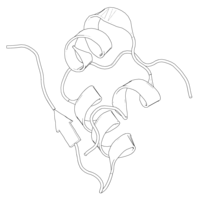











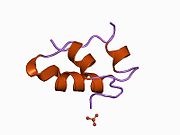

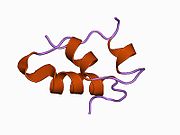


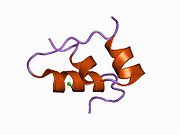
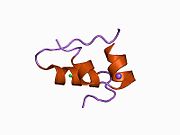
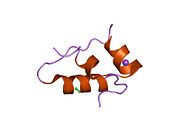

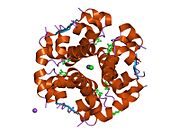






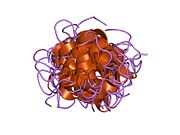



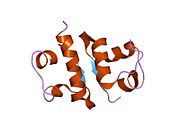
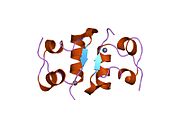
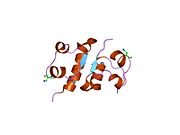

![1jco: Solution structure of the monomeric [Thr(B27)->Pro,Pro(B28)->Thr] insulin mutant (PT insulin)](https://upload.wikimedia.org/wikipedia/commons/thumb/9/9a/PDB_1jco_EBI.jpg/180px-PDB_1jco_EBI.jpg)



![1mhj: SOLUTION STRUCTURE OF THE SUPERACTIVE MONOMERIC DES-[PHE(B25)] HUMAN INSULIN MUTANT. ELUCIDATION OF THE STRUCTURAL BASIS FOR THE MONOMERIZATION OF THE DES-[PHE(B25)] INSULIN AND THE DIMERIZATION OF NATIVE INSULIN](https://upload.wikimedia.org/wikipedia/commons/thumb/e/e8/PDB_1mhj_EBI.jpg/180px-PDB_1mhj_EBI.jpg)

